Star Wars is a multi-genre mythology and multimedia franchise created by George Lucas in 1976. Comprising movies, novels, comics, video games, toys, and numerous television series, the Star Wars franchise employs archetypal motifs common to religions, classical mythology, and political climax, as well as musical motifs of those same aspects.
As one of the foremost examples of the space opera subgenre of science fiction, Star Wars has become part of mainstream popular culture, as well as being one of the highest-grossing series of all time.
In 2012, The Walt Disney Company bought the rights to the franchise from George Lucas for 4.05 billion dollars. Since then, Disney has split off Star Wars into two main categories, those being Star Wars Legends and Star Wars Canon, with Canon being the "official" story of the franchise.
The catalyst of the multimedia franchise was the release of its mainline story, officially known as the Skywalker Saga; a collection of 9 films released from the years 1977 to 2019, with the first and last release of Star Wars: Episode IV A New Hope and Star Wars: Episode IX The Rise of Skywalker, respectively. Despite the saga's ending, the franchise still continues strong, mainly due to the success of Disney+ original television series, both live-action, such as The Mandalorian, and animated, such as Star Wars: The Bad Batch, as well as publishing projects such as Star Wars: The High Republic.
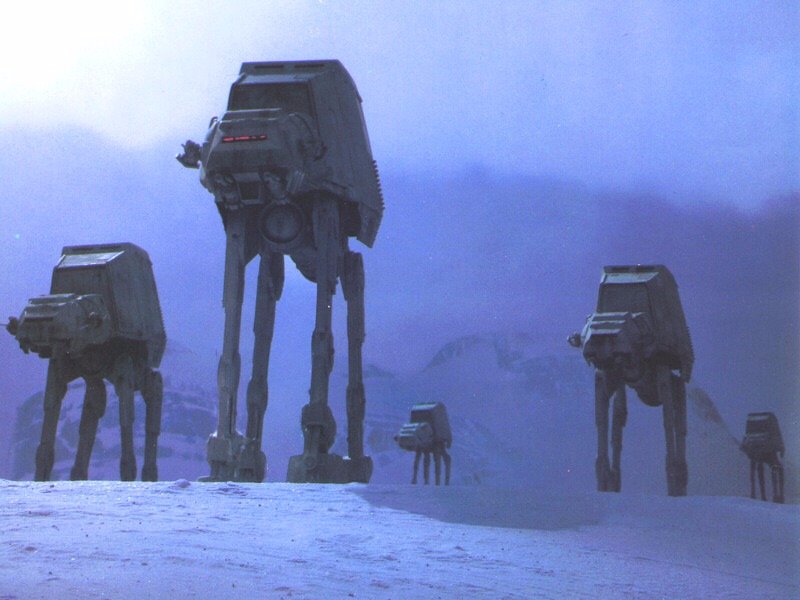
AT-ATs on Hoth
The Star Wars story has been presented in a series of American films, which have spawned a large quantity of books and other media, which have formed the Expanded Universe. The Star Wars mythos is also the basis of many toys and games of varying types. The films and novels employ common science-fiction motifs.
Whereas Gene Roddenberry's Star Trek, a science fantasy franchise that has enjoyed long-lasting popularity in American popular culture, and often combines magical/supernatural elements with a rational and progressive approach to storytelling, Star Wars has a strong mythic quality alongside its political and scientific elements.
Unlike the heroes of earlier space-set sci-fi/fantasy film and TV series, such as Flash Gordon, the heroes of Star Wars are not militaristic types but romantic individualists. College literature professors have remarked that the Star Wars saga, with its struggle between good and evil, democracy and empire, can be considered a national epic for the United States. The film has many visual and narrative similarities to John Ford's The Searches, which also provides a clue to the relationship between Leia Organa and Luke Skywalker.
George Lucas attributed the strong appeal of Star Wars to it being a mythology that takes from thousand-year-old psychological motifs and underpinnings of humanity. Particularly, Lucas saw children as the prime audience for such stories. The Star Wars films show considerable similarity to Japanese Jidaigeki films, as well as Roman mythology. Lucas has stated that his intention was to create in Star Wars a modern mythology, based on the studies of his friend and mentor Joseph Campbell. He has also called the first movie's similarity to the film The Hidden Fortress (Akira Kurosawa) an "homage."
The Star Wars films portray a world full of grime and technology that looks like it has been used for years, unlike the sleek, futuristic world typical of earlier science-fiction films. In interviews, Lucas tells of rubbing the new props with dirt to make them look weatherworn. Lucas may have been inspired by the Sergio Leone Spaghetti Western films of the 1960s, which performed a similar function on the Western many years earlier. It is tempting to speculate that this break from traditional science-fiction film influenced the cyberpunk genre that emerged around 1984.
Licensed Star Wars novels have been published since the original movie was released in 1977. Although these novels are licensed by Lucas (meaning he shares in the royalties), he retains ultimate creative control over the Star Wars universe, forcing Lucas Licensing to devote considerable ongoing effort to ensuring continuity between different authors' works and Lucas' films. Occasionally, elements from these novels are adopted into the highest tier of Star Wars canon, the movies. Books, games, and stories that are not directly derived from the nine movies of Star Wars are known as the Extended or Expanded Universe (EU for short). Lucas has said that he does not deeply involve himself in the EU, choosing instead to concentrate mainly on his movies instead of "…the licensing world of the books, games and comic books."
The original (1977) Star Wars (A New Hope) and the first sequel, The Empire Strikes Back (1980), have been selected for preservation in the United States National Film Registry.
In 1978, Lucas sued the creators of Battlestar Galactica for its similarity to Star Wars. The case was dismissed as having no merit in 1980 by a U.S. Federal judge.
The mainline story of Star Wars, known as the The Skywalker Saga, ended in 2019 with the release of Star Wars: Episode IX The Rise of Skywalker. However, the Star Wars franchise itself has not ended, and is continuing to move on past the story of the original saga with shows like The Mandalorian and the upcoming project known as the Star Wars: The High Republic.
Although George Lucas had made a name for himself among some industry insiders for his work at USC, it was not until the release of American Graffiti in August of 1973 that he reached stardom. The film grossed over $115 million at the box office and was dollar-for-dollar the most profitable film in the history of Hollywood at the time. Lucas' profit participation in Graffiti earned him over $7 million. Lucas was now a millionaire and one of the most sought after young directors in the world.
Alan Ladd, Jr., then the head of Twentieth Century Fox, saw a smuggled print of American Graffiti before it was released in theaters and was determined that Fox was going to be the next studio to profit from Lucas' genius.
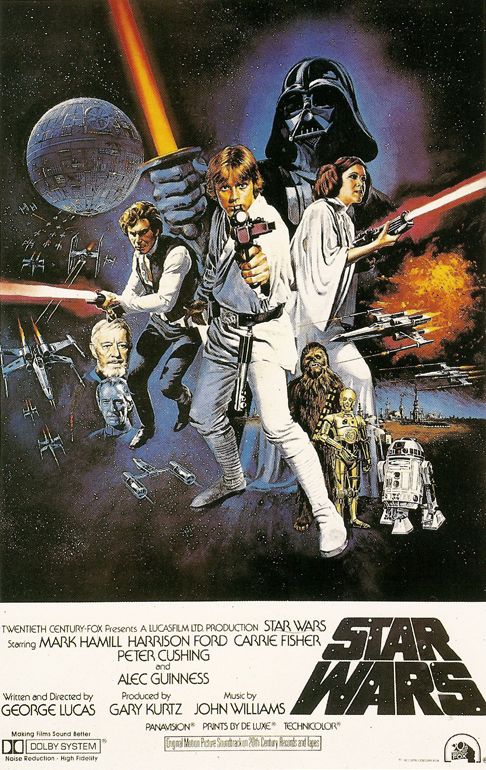
Poster art for Star Wars: Episode IV A New Hope
Many different influences have been suggested for the Star Wars films by fans, critics, and George Lucas himself. Lucas has said that the plot and characters in the 1958 Japanese film The Hidden Fortress, directed by Akira Kurosawa, was a major inspiration. Additionally, the film influenced Lucas to tell the story of Star Wars from the viewpoint of the humble droids, rather than a major player. It also played a role in the conception of Darth Vader, whose trademark black helmet intentionally resembles a samurai helmet.
George Lucas has often said that his original idea for the project that evolved into Star Wars was to remake the Flash Gordon movie serials from the 1930s (a "serial" is a movie shown in weekly installments of about 10-20 minutes each). The license wasn't available, so Lucas moved on to other ideas, beginning with Akira Kurosawa's film The Hidden Fortress and then Joseph Campbell's The Hero With a Thousand Faces. Despite the plot changes the Star Wars films are still bursting with influences from the Flash Gordon movie serials, including the Rebels vs. the Imperial Forces, Cloud City and even the famous "roll up" which begins the movie.
The second major direction for Star Wars (used in the 1973 synopsis) was to use the Flash Gordon "vocabulary" to create an outer-space version of the Samurai films of Akira Kurosawa, primarily Kakushi toride no san akunin (The Hidden Fortress, 1958), Yojimbo (1961) and Tsubaki Sanjūrō (Sanjuro, 1962). Joseph Campbell's The Hero With a Thousand Faces eventually gave Lucas a third and final major story direction, but many elements from Kurosawa's work remain, including the two bickering peasants (who evolved into the droids), and the queen who often switches places with her handmaiden. The Darth Vader-like evil general who has a change of heart at the end wears a kamon (a Japanese family crest) that looks very similar to the Japanese Imperial Crest.
Lucas had already written two drafts of Star Wars when he rediscovered Joseph Campbell's The Hero With a Thousand Faces in 1975 (having read it years before in college). This blueprint for "The Hero's Journey" gave Lucas the focus he needed to draw his sprawling imaginary universe into a single story. Campbell demonstrates in his book that all stories are expressions of the same story-pattern, which he named the Hero's Journey or the monomyth.
Lucas has often cited The Lord of the Rings series as a major influence on Star Wars. Lucas learned from Tolkien how to handle the delicate stuff of myth. Tolkien wrote that myth and fairytale seem to be the best way to communicate morality - hints for choosing between right and wrong - and in fact that may be their primary purpose. Lucas has also acknowledged in interviews that the Gandalf and the Witch-king characters in the Lord of the Rings influenced the Obi-Wan Kenobi and Darth Vader characters respectively.
There are many myths surrounding the writing of Star Wars, many perpetuated by Lucasfilm and George Lucas himself. Author Michael Kaminski tried to set the record straight in his book The Secret History of Star Wars, as did Jonathan Rinzler in The Making of Star Wars, both released in 2007.
Lucas' original concept was a swashbuckling space adventure movie. He says "the film was a good concept in search of a story". He first tried to have a child buy the rights to remake Flash Gordon, but was unsuccessful.
In 1971, United Artists agreed to make American Graffiti and Star Wars in a two-picture contract, though they would reject Star Wars in its early concept stages. Graffiti was made first, and when it was completed in 1973, Lucas set to work on making his space adventure movie. In early 1973, Lucas wrote a short summary called "The Journal of the Whills," which told the tale of the training of apprentice C.J. Thorpe as a "Jedi-Bendu" space commando by the legendary Mace Windy.
Frustrated that his story was too hard to understand, Lucas wrote a 13-page treatment called The Star Wars, which loosely based on the structure of Akira Kurosawa's The Hidden Fortress. By 1974, he had expanded the treatment into a rough-draft screenplay, which added elements such as the Sith and the Death Star, and once more had the protagonist as a young boy, named Annikin Starkiller. For the second draft, Lucas made heavy simplifications, and also introduced the young hero on a farm, with his name now Luke rather than Annikin. Luke/Annikin's father is still an active character in the story at this point, a wise Jedi knight, and "the Force" now became a supernatural power. The next draft removed the father character and replaced him with a substitute named Ben Kenobi, and in 1976 a fourth draft had been prepared for principal photography. The film was titled Adventures of Luke Starkiller, as taken from the Journal of the Whills, Saga I: The Star Wars. During production, Lucas changed Luke's last name to Skywalker and altered the title to just The Star Wars and finally Star Wars.
At this point, Lucas was thinking of the film as the only entry that would be made—the fourth draft underwent subtle changes that made it more satisfying as a self-contained film that ended with the destruction of the Empire itself, as the Death Star was said to achieve; possibly this was a result of the frustrating difficulties Lucas had encountered in pre-production during that period. However, in previous times Lucas had conceived of the film as the first in a series of adventures. The second draft contained a teaser for a never-made sequel about "The Princess of Ondos," and by the time of the third draft some months later, Lucas had negotiated a contract that gave him rights to make two sequels. Not long after, Lucas met with author Alan Dean Foster and hired him to write these two sequels—as novels. The intention was that if Star Wars was successful—and if Lucas felt like it—the novels could be adapted into screenplays. He had also by this point developed a fairly elaborate backstory—though this was not designed or intended for filming; it was merely backstory. "The backstory wasn't meant to be a movie," Lucas has said.
When Star Wars was successful, and not just successful but the biggest hit ever made at that time, Lucas decided to use the film as a springboard for an elaborate serial, although he considered walking away from the series altogether. However, Lucas wanted to create an independent filmmaking center—what would become Skywalker Ranch—and saw an opportunity to use the series as a financing agent for him. Alan Dean Foster had already begun writing the sequel as a novel, but Lucas decided to disregard that for filming and create more elaborate film sequels; the book was released as Splinter of the Mind's Eye the next year. At first Lucas envisioned an unlimited number of sequels, much like the James Bond series, and in an interview with Rolling Stone in August of 1977 said that he wanted his friends to take a try directing them and giving unique interpretations on the series. He also said that the backstory where Darth Vader turns to the dark side, kills Luke's father and fights Ben Kenobi on a volcano as the Republic falls would make an excellent sequel. Later that year, Lucas hired sci-fi author Leigh Brackett to write "Star Wars II" with him. They held story conferences together, and in late November of 1977 Lucas had produced a handwritten treatment called The Empire Strikes Back. The story is very similar to the final film except Darth Vader does not reveal he is Luke's father. In the first draft that Leigh Brackett would write from this, Luke's father appears as a ghost to instruct Luke.
During this period, Lucas had now had time to attach a numeric figure to the amount of sequels—he revealed to Time magazine in March 1978 that there would be twelve films altogether. This was then revealed in the official Star Wars fanclub newsletter, Bantha Tracks. The figure of 12 was likely selected due to its tradition in serial episodes.
Brackett finished her first draft of The Empire Strikes Back in early 1978; Lucas has said he was disappointed with it, but before he could discuss it with her she had died from cancer. With no writer available, Lucas had to write his second draft himself. Here Lucas finally made use of the "Episode" listing in the film—The Empire Strikes Back was Episode II. As Michael Kaminski argues in The Secret History of Star Wars, the disappointment with the first draft probably made Lucas consider different directions to take the story in. Here he made use of a new plot twist: Darth Vader says he is Luke's father. According to Lucas, he found this draft enjoyable to write, as opposed to the year-long struggles of the first film, and quickly wrote two more drafts in the same month—April of 1978—which both retained the new Vader-as-father plot. He also took this darker ending farther by imprisoning Han Solo in carbonite and leaving him in limbo.
This new storyline where Vader was Luke's father had drastic effects on the series. Michael Kaminski argues in his book that it is unlikely that this was a plot point that had seriously been considered before 1978, or even thought of before then, and that the first film was clearly operating under an alternate storyline where Vader was separate from Luke's father; there is not a single reference to the Vader-as-father plot point before 1978. After the second and third drafts of The Empire Strikes Back, where Lucas first introduced this point, he reviewed the new backstory he had now created: Annikin Skywalker is Ben Kenobi's brilliant student, has a child (Luke) but is swayed to the dark-side by the Emperor (who was now a Sith and not just a politician), battles Ben Kenobi on the site of a volcano and is wounded but resurrected as Darth Vader; meanwhile, Kenobi hides Luke on Tatooine while the Republic becomes the Empire and Vader has hunted down the Jedi Knights. With this new backstory, Lucas decided to film this as a trilogy—moving The Empire Strikes Back from Episode II to Episode V in the next draft. Lawrence Kasdan, who had just completed writing Raiders of the Lost Ark, was then hired to write the next drafts, and was helped by additional input from director Irvin Kershner. Kasdan, Kershner, and producer Gary Kurtz saw the film as a more serious and adult film, which was helped by the new, darker storyline, and brought the series far away from the light adventure roots it had existed as only a year earlier.
Lucas had also around this time developed a third trilogy as well, which took place twenty years after Episode VI.
By the time of writing Episode VI—Revenge of the Jedi, as it was then known—in 1981, much had changed. Making The Empire Strikes Back was stressful and costly, and Lucas' personal life was disintegrating. Burnt out and not wanting to make any more Star Wars films, he vowed to be done with the series, as he makes explicit in a May 1983 interview with Time magazine. Lucas' 1981 rough drafts of Revenge of the Jedi had Darth Vader competing with the Emperor for possession of Luke—and in the second script, the "revised rough draft," Vader was turned into a sympathetic character. Lawrence Kasdan was hired to take over once again, and in these final drafts Vader was explicitly redeemed, and finally unmasked. This change in character would provide a springboard for the "Tragedy of Darth Vader" storyline in the prequels.
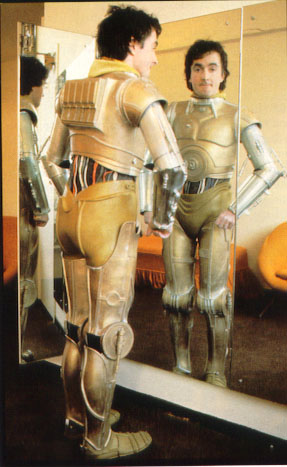
Anthony Daniels reflects (literally) on his portrayal of C-3PO
Since most major motion-picture companies no longer had special-effects teams, or they thought the American public was no longer interested in nonrealistic films, George Lucas had to create one from scratch. He eventually put together a team of model makers and special-effects people to create Industrial Light & Magic. The team worked in a run-down part of Van Nuys in a cramped work space that no one liked. Lucas himself bought old equipment for pennies on the dollar.
Meanwhile, George Lucas was looking for actors for Star Wars. Lucas had decided to go with a group of unknowns, against the advice of his friend Francis Ford Coppola, who had picked famous stage and screen actors for The Godfather. Hundreds of actors and actresses tried out for the three main roles, Luke Skywalker, Princess Leia and Han Solo. Actors like Burt Reynolds and actresses like Jodie Foster tried out for the parts, but Lucas eventually chose 25-year-old Mark Hamill (who had only worked on television) as Luke Skywalker and 19-year-old Carrie Fisher, daughter of Eddie Fisher and Debbie Reynolds, as Princess Leia. Initially, Harrison Ford was not eligible for the role of Han Solo because he had worked with Lucas on American Graffiti but eventually swayed Lucas over after helping the other actors and actresses with their lines and got the part.
After casting the initial group, Lucas had to find actors for two of the film's droids, C-3PO and R2-D2. ILM had made some quaint remote-controlled robots, but these parts would require living actors. In came three-foot comedian Kenny Baker. Due to his shortness and the fact that kids could not control this heavy machine, he got the part of R2. Anthony Daniels, however, did not want the part of C-3PO until he saw a drawing of C-3PO by Ralph McQuarrie, and he instantly wanted the part and got it. Lucas eventually found Australia native Peter Mayhew, who was over seven feet tall, making him the perfect size for Han Solo's furry Wookiee counterpart, Chewbacca. After casting all the characters, Lucas began production on Star Wars in mid-1976.
The cast and crew of Star Wars began filming in Tunisia, North Africa where mid-morning temperatures reached 105 degrees. Many crew members and cast workers thought the movie was a joke and between problems on props and machinery, during filming Tunisia had their largest rainstorm in many years. Through it all Alec Guinness, the Academy Award–winning actor who was cast as the wise mentor Obi-Wan Kenobi, kept up a positive attitude and inspired the cast. The only silver lining was that after Africa, the team would be filming at a more controlled area, Elstree Studios in London.
After finishing up filming in Africa, the entire cast and crew of Star Wars finally came together to film the action sequences on the Death Star battle station. While this was happening, problems at ILM were far worse than the filming ones. Lucas eventually had to supervise every day at ILM, causing him to nearly have a heart attack. Meanwhile, Fox studios had had enough of George Lucas and his "kid's movie" and asked Alan Ladd, Jr. to terminate the project. Instead, Alan told Lucas he had only a few weeks to finish filming or have his movie fail. The last few climactic scenes were finished quickly with Lucas biking from soundstage to soundstage. Eventually, the film was finished, and the process to edit and fix his film began.
When Lucas saw the first cut of his film, he was horrified. To make matters worse, he had to fire his editor. Luckily, his replacements (including his then wife Marcia) greatly improved the film, but Lucas still insisted on reshooting some scenes. This, among other reasons, forced Fox to move the release date from Christmas 1976 to summer 1977. After showing the film without its music score to some of his friends, only Steven Spielberg, who had recently become an A-list director with the release of Jaws, liked it. However, when Fox executives saw it they loved it. With his film cut and most of the sounds for the film completed (and with the help of Ben Burtt), Lucas started to think about his film's score. It was Spielberg who recommended John Williams (who had just scored Jaws). This was considered a gutsy move because thematic scores were out of style at the time, but Lucas went ahead with it.
After the score was completed, Lucas began to market his picture. However, many people thought it would be a flop, so not many people went with him. One company that did, however, was the toy company Kenner Products, who decided to make a few figures for the release. Eventually, Lucas's film was released on May 25, 1977. It would be a day they would never forget.
When Star Wars opened, it initially opened at a few theaters. A month after its release, Star Wars played at almost every theater in the country and hundreds worldwide. People, especially children, flocked to see the adventures of Luke Skywalker, Han Solo and Princess Leia again and again and again. Lines stretched for miles. Kenner, caught up in a vortex, ran out of toys by early fall of the film's release. So, the infamous "Empty Box" scheme was formed. Fox's stock rocketed up. Merchandise flew off the shelves by the thousands and Lucas became very rich. Star Wars run eventually ended by early 1978 with over 260 million dollars, making it the most successful film in history at that time. It would be re-released over the next 20 years, adding 220 million to its overall total. Currently, it is the second-highest American grossing film of all time (in inflation-adjusted dollars), second only to Gone with the Wind.
Star Wars was nominated for 10 Oscars including Best Picture and won 6 of them. But just being nominated for it showed Fox and Lucas, who knew all along, that this was not a "kids' film."
In 1978, with George Lucas a millionaire, he began taking his screenplays for Episodes V and VI and turning them into films, as, despite later declarations, he was already developing the idea of a "trilogy of trilogies" of which Star Wars would have been only Episode IV. In early 1978, Lucas began working on Star Wars: Episode V The Empire Strikes Back. Star Wars was also retitled Star Wars: Episode IV A New Hope. However, this time Lucas left the Director's Guild, and Irvin Kershner was the new director with Lucas as the producer. Filming began in mid to late 1978 with the snowy planet of Hoth scenes being filmed in Norway. However, during filming, as if a curse, Norway suffered their worst snowstorm in many years. Mark Hamill, who was still recovering from his car accident injuries, filmed in a scene in the snow while the crew stayed in their hotel rooms. After the filming there concluded, the next part of the filming process turned to Elstree Studios.
Since Lucas wanted this movie to be bigger and more spectacular than Star Wars, more sets were made and new characters were introduced, which included the first black Star Wars character, Lando Calrissian, played by Billy Dee Williams, and a 2-foot puppet named Yoda voiced by Frank Oz. It was also the first time that Han Solo and Princess Leia kissed. But the biggest surprise was Darth Vader's revelation to Luke. A few minutes before shooting that scene, Kershner told Hamill that Vader was Luke's father. To stop the big reveal leaking, David Prowse, the man in the Vader suit, was given a different line to say on set, "Obi-Wan killed your father." When they recorded Vader's dialogue with James Earl Jones, the line was This line would later spark the lightsaber duel in Episode VI and all the prequels.
Many people believed that the sequel would not be as good as Star Wars, but audiences didn't think so. The Empire Strikes Back took in 6.4 million dollars of the weekend of May 21, 1980. It was also considered the darkest Star Wars movie until Star Wars: Episode III Revenge of the Sith was released. However, its gross in the U.S. ended at 290 million dollars, making it the lowest-grossing Star Wars movie.
Before beginning the production of Episode VI, Lucas, using the profits from Star Wars and Empire, made Skywalker Ranch, a place where friends of Lucas could hang out and work on movies, mostly Star Wars–related things. It would be used more during the making of the prequel trilogy.
In early 1982, Lucas still out of the director's chair, Richard Marquand began shooting Revenge of the Jedi. Some of the new things in the films included a speeder-bike chase, a second Death Star and one of the most controversial groups of characters in Star Wars history, the Ewoks. Also, to keep the title of Episode VI from leaking out, the title Blue Harvest: Horror Beyond Imagination was the working "title" of the movie. After filming for Jedi completed, a few months before the film's release, Lucas changed the title to Return of the Jedi, stating, "revenge was not a quality of the Jedi," although some industry insiders attribute the title's change to Star Trek II : Wrath of Khan being released around the same time and Fox, and possibly Lucas, not wanting audiences confused between the similar titles. The "Revenge" title would eventually be used for Episode III.
After Jedi broke single- and opening-day box office records on May 25, 1983, six years after the original Star Wars opening, George Lucas's wife divorced him, leaving him to raise his children. Afterwards, Lucas established several Lucasfilm companies including THX Sound and Picture, the Animation Studios (which would later be sold to Disney), and several others. In May 1987, ten years after the first movie's release, Lucas announced a second trilogy and hinted at a third. In mid-1996, with all the technology necessary, Lucas began working on the Star Wars movies the way he wanted them, adding new scenes and changes along with THX Sound and excellent picture quality.
Beginning with Splinter of the Mind's Eye, the Star Wars Expanded Universe was populated by a slow trickle of novels, comic strips and television specials.
Almost a decade after the release of Return of the Jedi, Star Wars merchandising sales had ground to a halt. In an effort to revitalize interest and capitalize on the success of other franchises in books, Bantam Spectra and Lucas Licensing planned a four-year publication run that would include several Star Wars novels.
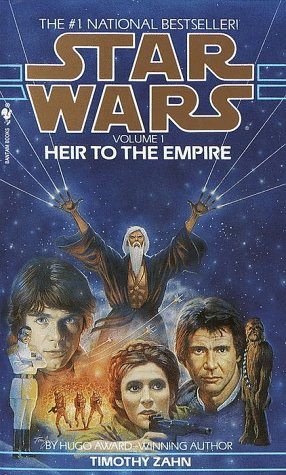
Heir to the Empire re-ignited the Expanded Universe in 1991.
It was 1991's Heir to the Empire that sparked the success of the first run of new novels and signaled a renaissance in Star Wars publishing. The Thrawn Trilogy by Hugo Award–winning author Timothy Zahn would become one of the most popular science-fiction series to date, and introduced some of the Expanded Universe's best-known characters, like Grand Admiral Thrawn, Mara Jade and Gilad Pellaeon. Bantam would continue to publish dozens of books across a number of eras, leading to the use of era markers after Bantam was sold to Del Rey.
But books were just the beginning. In the same year as Zahn's success, Dark Horse Comics released Star Wars: Dark Empire, the first serious Star Wars graphic novel. It too would be followed by dozens of comic series.
Star Wars video and computer games also contributed to the Expanded Universe, but 1996's Shadows of the Empire multimedia campaign marked a turning point. The simultaneous release of a novel, video game, comics, soundtrack, toys and other promotional tie-ins set the standard that would later be followed for the merchandising efforts of the prequel trilogy and expanded upon for the Clone Wars.
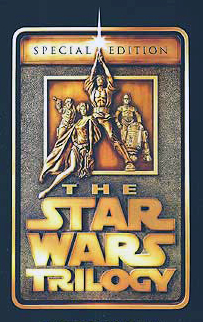
The Special Edition logo
In the 1990s, with ILM's advancement in technology, George Lucas sought to refine his Star Wars films, and began altering them to in an effort to fulfill his original intentions when creating the films. New scenes were added as a result, although some minor aesthetic changes came to be items of controvery amongst fans. Despite this, some fans praised other changes.
After getting a divorce in 1983 and losing much of his fortune, Lucas had no desire to return to Star Wars, and had unofficially canceled his sequel trilogy by the time of Return of the Jedi. However, the prequels, which were quite developed, remained fascinating to him. After Star Wars became popular once again, in the wake of Dark Horse's comic line and Timothy Zahn's Thrawn Trilogy novels, Lucas saw that there was still a large audience. His children had begun to grow older, and with the explosion of CG technology, he was now considering returning to directing. By 1993 it was announced, in Variety among other sources, that he would be making the prequels. He began outlining the story, now offering that Anakin Skywalker would be the protagonist rather than Ben Kenobi and that the series would be a tragic one examining his transformation to evil. He also began to change how the prequels would exist relative to the originals—at first they were supposed to be a "filling-in" of history, backstory, existing parallel or tangential to the originals, but now he began to see that they could form the beginning of one long story: beginning with Anakin's childhood and ending with Anakin's death. This was the final step towards turning the franchise into a "Saga."
In 1994, Lucas began writing the first screenplay, titled Episode I: The Beginning. At first the plan was to write and then film all three prequels at once, but this was changed, possibly because the writing process took much longer than first thought. Although Lucas initially planned on having others write and direct, he kept writing on his own, and eventually decided to direct the film as well. In 1999, Lucas announced he would be directing the next two films as well, and began working on Episode II at that time. The first draft of this was completed just weeks before principal photography, and Lucas hired Jonathan Hales, a writer from The Young Indiana Jones Chronicles, to polish his draft. Unsure of a title, Lucas had jokingly called the film Jar Jar's Big Adventure. By now the backstory had undergone large changes—Ben Kenobi had discovered Anakin as an adult in Episode I's first draft, but he was changed to be a young student, and Anakin a child, and in Episode II the Clone Wars were decided to be a personal manipulation of Palpatine's. At the time of the original trilogy, Lucas had many ideas for this war: in The Empire Strikes Back it was decided that Lando was a clone and came from a planet of clones that caused a war, but later a different version was decided wherein "Shocktroopers," including Boba Fett, waged war against the Republic from a distant galaxy but were then repelled by the Jedi Knights.
Lucas began working on Episode III even before Attack of the Clones was released, offering concept artists that the film would open with a montage of seven Clone War battles. As he reviewed the storyline that summer, however, he says he radically re-organized the plot. Michael Kaminski, in The Secret History of Star Wars, offers evidence that issues in Anakin's fall to the dark side prompted Lucas to make massive story changes, first revising the opening sequence to have Palpatine kidnapped and Dooku killed by Anakin as a first act towards the dark side. Lucas' first draft was written in 2003, and is largely similar to the film, though much simplified. After principal photography was complete in 2003, Lucas made even more massive changes in Anakin's character, rewriting his entire turn to the dark side—he would now turn out of a quest to save Padmé from dying, rather than the previous version where that was one of many reasons and genuinely believed that the Jedi were evil and plotting to take over the Republic. This fundamental rewrite was accomplished through editing and many new and revised scenes filmed in additional pick-ups in 2004.
George Lucas has often exaggerated the amount of material he had written for the series, most of these exaggerations stemming from the post-1978 period where the film grew into a true phenomenon. Lucasfilm often indicated that he had written twelve stories to be filmed, and Lucas was quick to tell how Star Wars was always Episode IV that was meant as a middle chapter. Lucas also began to claim that Darth Vader's parentage of Luke and redemption was always a major part of his plan from early on, and even that this was his very first script or treatment. As Jonathan Rinzler and Michael Kaminski show, this is demonstrably false. Kaminski rationalizes that these exaggerations are part publicity device and part security measure—with the series and story radically changing throughout the years, Lucas would emphasize that its current embodiment was the original intention; with the series previously existing as different and often contradictory forms, this makes audiences view the material only from the perspective that Lucas wishes them to view the material, and it also may protect against outrage that such a popular storyline was being changed post-release after being cherished by so many.
Information on the screenplays comes from many sources. Most of the drafts of Star Wars were leaked to the public in 1977 and have circulated since then. 1987's Annotated Screenplays thoroughly documented the early drafts of the trilogy, and Rinzler's The Making of Star Wars supplemented this info with even more detail, including drafts which had not yet been publicly leaked, as well as Lucas' personal notes. Information on the prequel scripts is comparatively more scarce, but a number of making-of books give insight into the writing process and early drafts. The prequels' drafts are largely similar to the final films due to Lucas exploring ideas in the art department rather than on paper.
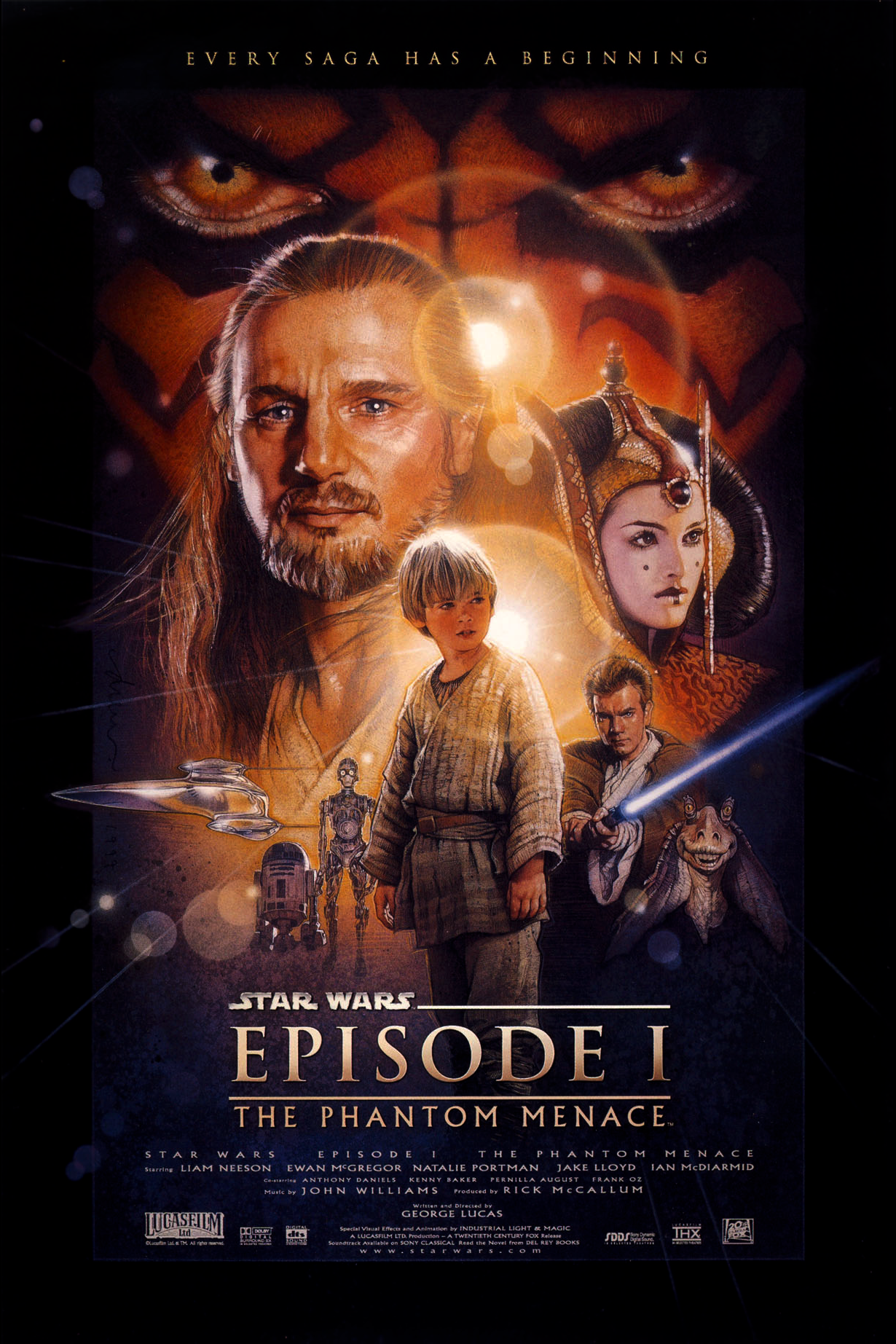
Poster art for Star Wars: Episode I The Phantom Menace
In 1994, George Lucas began writing his prequel trilogy, which was to be made in the coming years. In 1997, production for Star Wars: Episode I The Phantom Menace began. Lucas would revisit Tunisia, Africa and have more problems there as his Star Wars past came to haunt him. However, this time Lucas filmed all non-location photography in Leavesden Studios, England.
After wrapping up filming, Lucas started finishing the special effects and other small things. This would eventually be his last film filmed on regular film. Meanwhile, while Lucas was wrapping up his film, the first Star Wars: Celebration took place, which celebrated the release of Episode I and would recur for Episodes II and III.
After his film was released on May 19, 1999, Lucas soon started writing Episode II while The Phantom Menace broke box-office records and grossed more than 900 million dollars worldwide, despite poor reviews and reaction to the acting and general appearance of characters, in particular the much-maligned Jar Jar Binks.
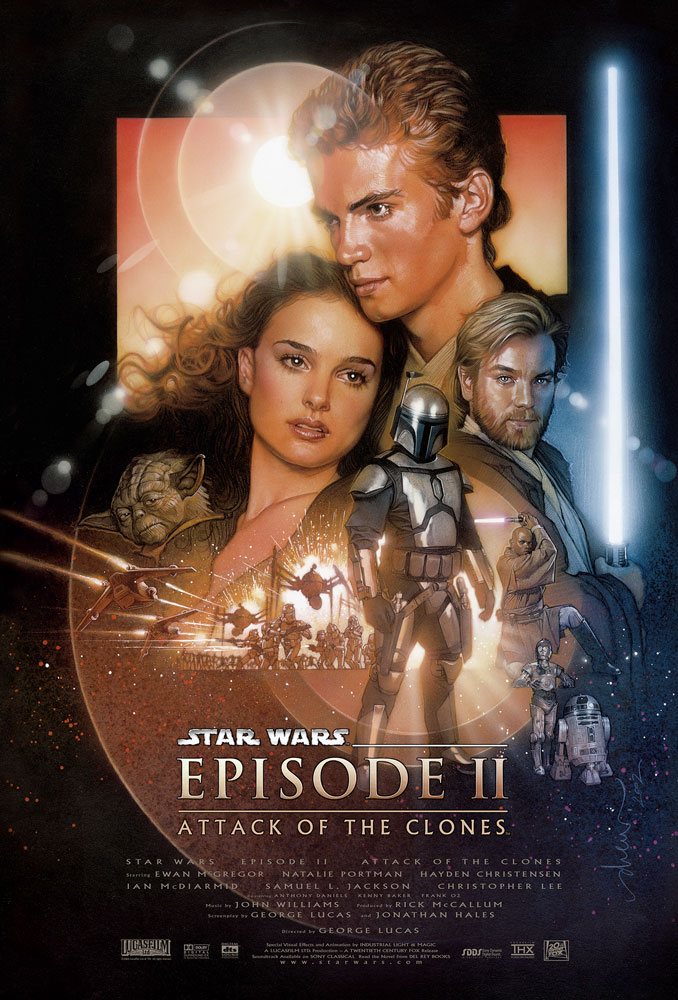
Poster art for Star Wars: Episode II Attack of the Clones
Filming for Star Wars: Episode II Attack of the Clones started at Fox Studios, Sydney, Australia with new actors like Hayden Christensen and the return of the now-famous Ewan McGregor and Natalie Portman along with a fully digitized Yoda.
However, when the film was released, many people criticized Lucas's love scenes and dialogue as well as Hayden's portrayal of a "whiny" Anakin. It became the first Star Wars film not to be the top-earning film of the year, placing only fourth globally (second to Spider-Man in North America).
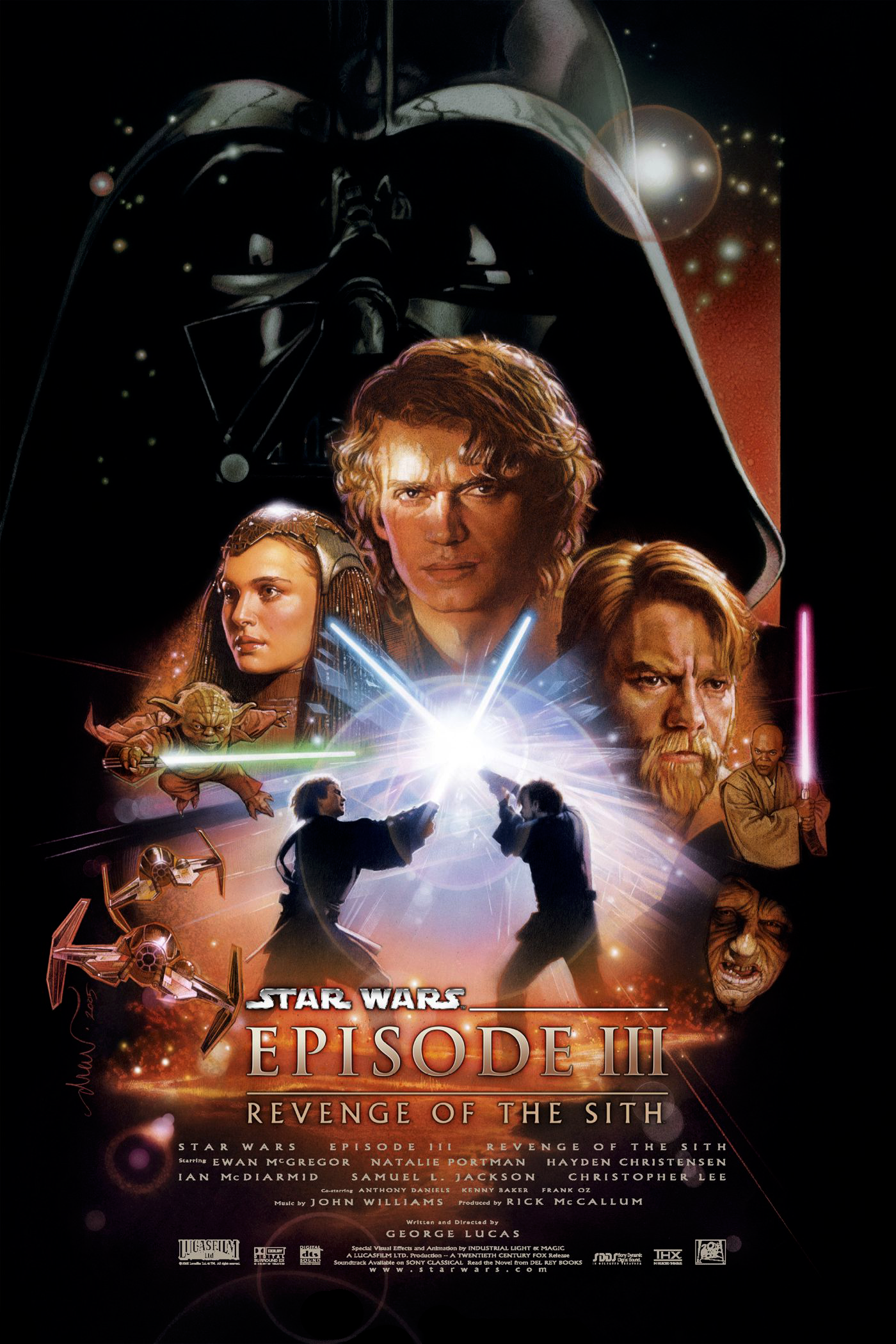
Poster art for Star Wars: Episode III Revenge of the Sith
In late 2002, Lucas began writing the screenplay for his last Star Wars film, Star Wars: Episode III Revenge of the Sith, what would be the darkest Star Wars film. Anakin turns to the dark side, the Jedi Order is destroyed and Palpatine becomes Emperor. It would be a heartfelt moment when the last scene was finished and the cast left on their separate ways foreseeable the premiere in May 2005.
The film received praise from critics as well as fans. Revenge of the Sith broke midnight, opening, three-day and five-day records, becoming the fastest film to reach $100 million and $300 million. It has so far grossed $848 million and became the second highest grossing film of 2005 in a year of letdowns at the box office.
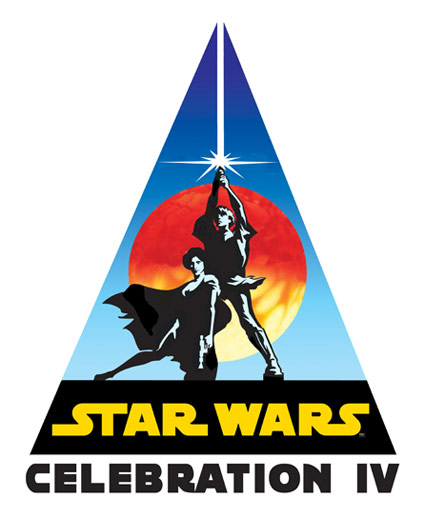
The logo for Celebration IV
After the completion of the prequels, Lucas began work on various Star Wars projects, including a new Clone Wars animated series, a live-action series, and a 3D conversion of all six films. The Clone Wars debuted in late 2008 and The Phantom Menace was released to theaters in 3D on February 10, 2012. However, the live-action series was put on hold due to budgetary issues.
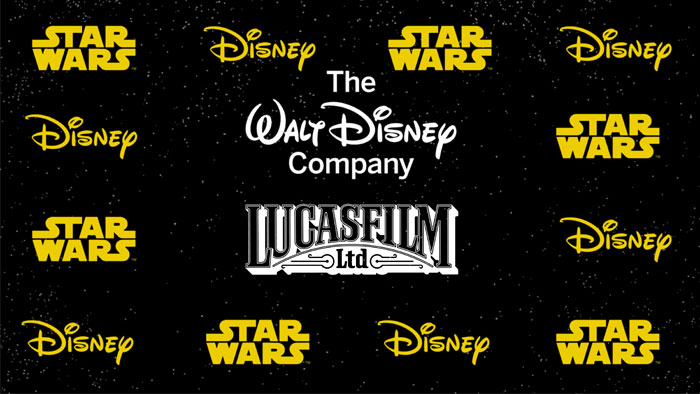
Disney acquires Lucasfilm for $4.05 billion USD.
George Lucas announced his retirement from filmmaking on January 2012, stating that the birth of his daughter, his older age relative to the decade he estimated it would take him to produce any potential sequel trilogy, his plans to build a museum, his desire for hands-on control, and his desire to enjoy his life were his motivations. While in New York for The Daily Show, Lucas had lunch with veteran producer and filmmaker Kathleen Kennedy, asking her if she would serve as co-chair of Lucasfilm with the intention of transferring leadership to her entirely after roughly one year. On June 1, 2012, Kennedy began her tenure at Lucasfilm, and Lucas proposed that they begin work on the sequel trilogy. At this time, Lucasfilm began early development on Episodes VII, VIII, and IX, hiring Michael Arndt to begin work on Episode VII with Lawrence Kasdan as a consultant.
After considering directing Episode VII himself, Lucas and his company entered into negotiations with The Walt Disney Company and CEO Robert Iger in June 2012, with negotiations ongoing for five months. Lucas ensured that vital Lucasfilm personnel would remain, and was initially hesitant to lose control over the new Star Wars films but had his fears reassured. Lucasfilm's acquisition was announced on October 30, 2012, for which Disney paid Lucas USD $4.05 billion. As part of the announcement, Disney revealed that it would be producing the sequel trilogy and new films.
On November 9, 2012, Lucasfilm confirmed that pre-production began on Episode VII, and that Michael Arndt would write the script. Arndt worked on the Episode VII script throughout 2013, and at some point, Lucas's story outlines for the sequels were set aside. A writer's room was assembled, including Arndt, Kiri Hart, Lawrence Kasdan, Kathleen Kennedy, and Simon Kinberg.
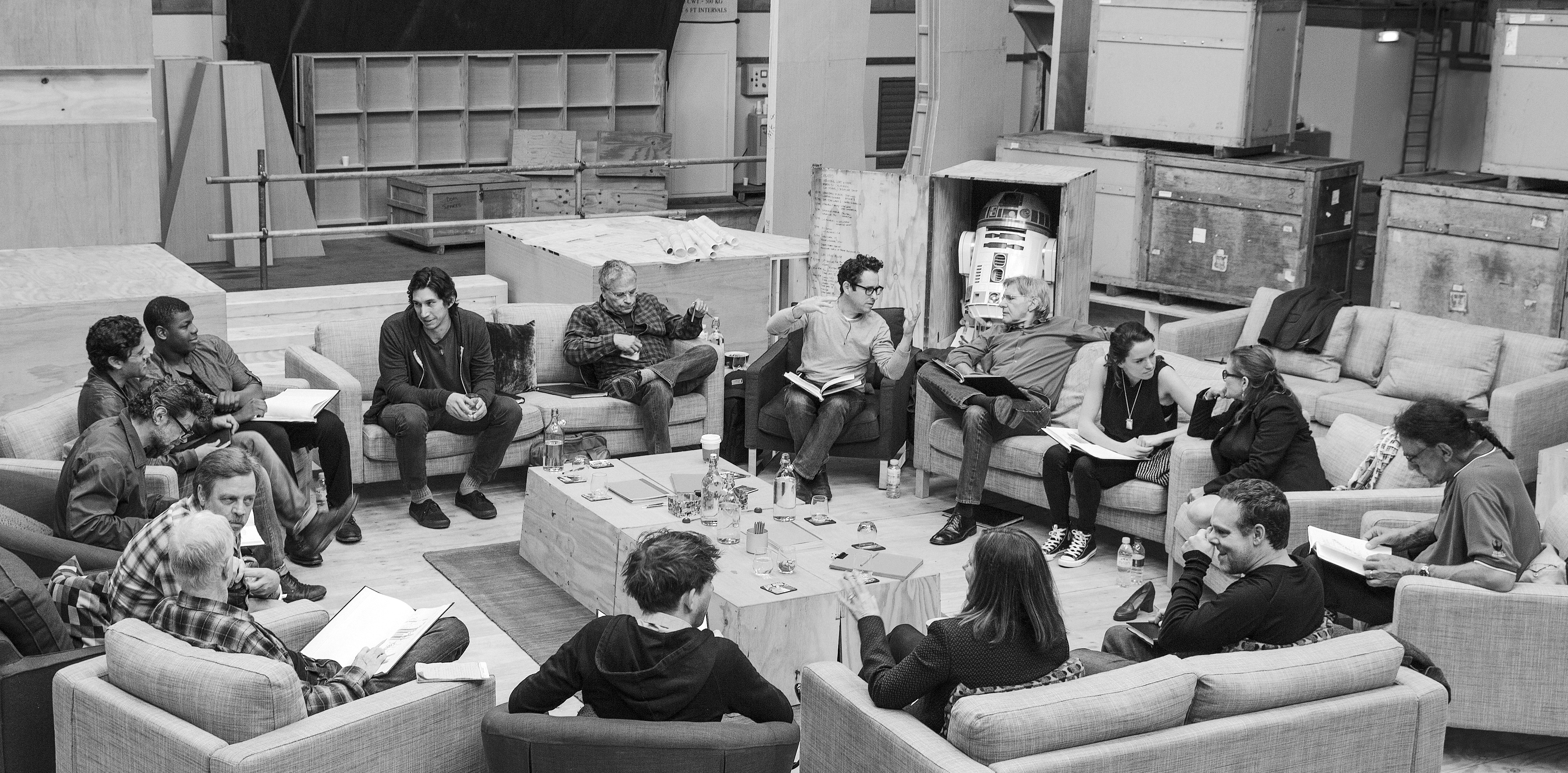
A roundtable with the cast of Episode VII.
As Lucasfilm developed the script for Episode VII, production for two theme park expansions for Disneyland and Walt Disney World centered on Star Wars began in 2013. A new Star Wars animated TV series, Star Wars Rebels, was first announced on March 11, 2013 as an untitled animated series set to replace Star Wars: The Clone Wars. Production had long been underway by May 2013, with the first season finishing pre-production by December of that same year.
Meanwhile, writing sessions for Episode VII continued for months with little progress. Abrams described these sessions as many ideas and outlines, with "a lot of cards on the wall, a lot of writing on whiteboards." Eventually, Arndt was removed from the project, and Kasdan was asked to co-write a new script with Episode VII director J.J. Abrams in November 2013. By January 2014, Abrams and Kasdan had developed a script, though they were still developing major story elements even after production began in May of that year as they were under immense pressure to deliver the script in a short period of time. Preliminary filming began the previous month, in April.

Star Wars Rebels was the first new visual media that was released post-Disney acquisition.
By March 2014, the entire first season of Star Wars Rebels was mapped out, with the series being executive produced by Dave Filoni, Simon Kinberg, and Greg Weisman. On April 25, 2014, Lucasfilm announced that the Expanded Universe of Star Wars would be rebranded as Star Wars Legends effective immediately. At that point, the only Star Wars material that was considered official and current canon was the six original films of the Star Wars saga, the Star Wars: The Clone Wars film, the Star Wars: The Clone Wars series, certain material from the StarWars.com website, certain exceptions, and upcoming material. Some content was excluded, and continued to be stories within Star Wars Legends, such as the expansions for Star Wars: Knights of the Old Republic, that were not yet completed. To ensure that all future material was consistent with previous canon storytelling, the Lucasfilm Story Group was created. At this same time, new releases were announced, including new novels and games.
On May 22, 2014, Lucasfilm announced that Gareth Edwards and Gary Whitta would develop a stand-alone Star Wars film, the first in the Star Wars Anthology Series. Star Wars Rebels premiered with four shorts on August 11, 2014, with the first two episodes serving as a singular movie titled Star Wars Rebels: Spark of Rebellion on October 3. The day prior, on October 2, Lucasfilm confirmed that Disney XD ordered a second season of Rebels. Thirteen more episodes were released, culminated in the season finale on March 2, 2015. Months prior, the first sequel trilogy film, Star Wars: Episode VII The Force Awakens finished principal photography on November 6, 2014.
On March 12, 2015, Lucasfilm announced that the stand-alone film was titled Rogue One: A Star Wars Story and that it would release in December 16 of the following year. It was also announced that Rian Johnson would write and direct the next film in the Star Wars saga, Episode VIII. Star Wars Rebels Season Two premiered with another TV film consisted of the first two episodes, Star Wars Rebels: The Siege of Lothal. The film aired on June 20, 2015. On July 7, 2015, Lucasfilm revealed that Christopher Miller and Phil Lord were directing a second stand-alone film focusing on legendary and classic character Han Solo. Principal photography for Rogue One began in August in London. The rest of the second season of Rebels premiered on October 14 of the same year, with episodes released weekly. The third season of Star Wars Rebels was announced on November 30.
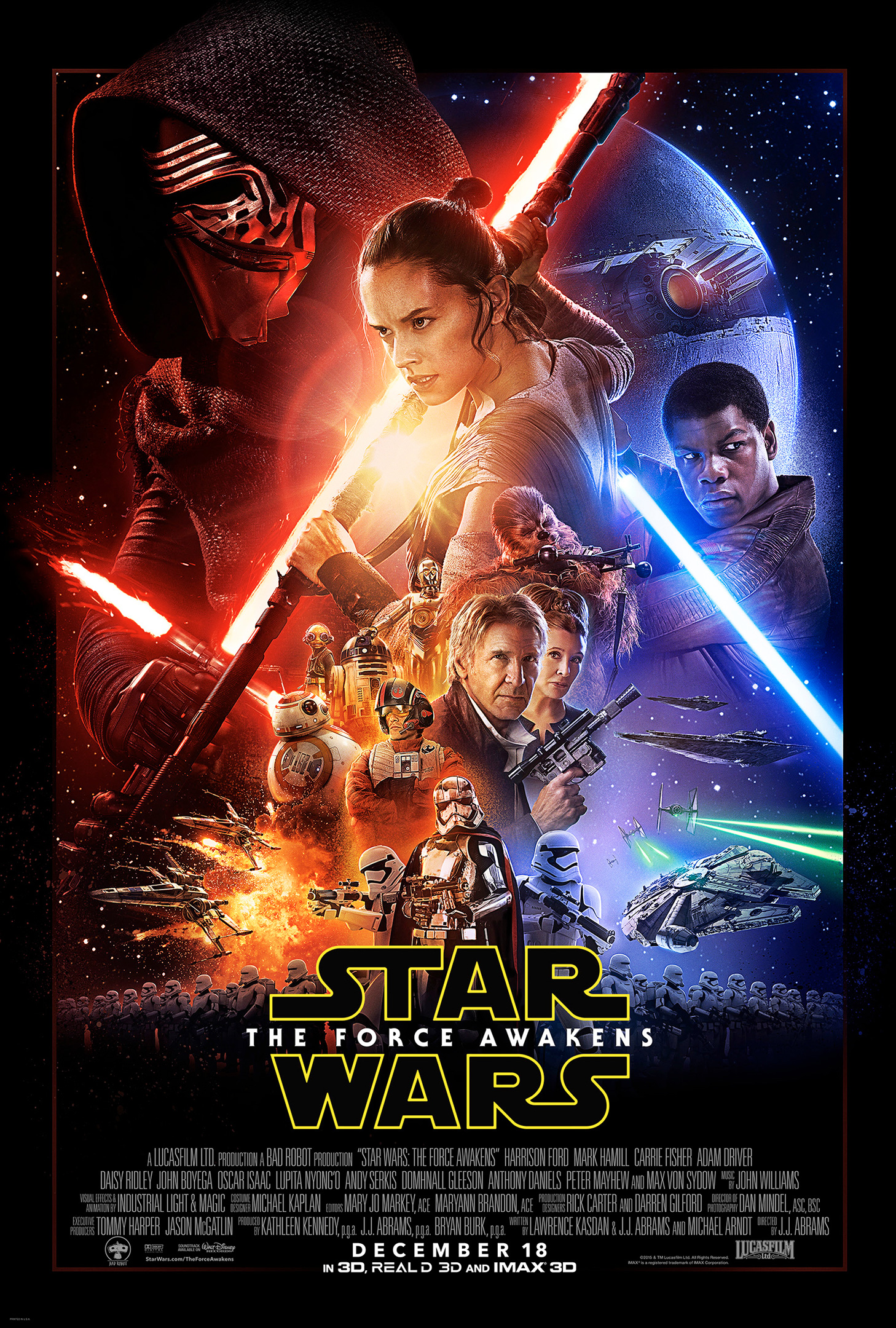
Episode VII, titled Star Wars: The Force Awakens, was the first theatrical release in the Skywalker saga since 2005, ten years prior.
By this time, The Force Awakens was widely marketed and promoted ahead of its premier, finally releasing on December 18, 2015. According to industry reports, The Force Awakens had an estimated budget of $200 million USD, ultimately earning $2.069 billion USD by the end of its original theatrical run in early 2016, making it the highest grossing Star Wars film. Soon after, principal photography began on Episode VIII in February. The second season of Star Wars Rebels ended on March 30, 2016, with the episode "Twilight of the Apprentice."
Celebration Europe was held in London from July 15 to July 17. On July 22, Episode VIII finished principal photography. Keeping with the format, the first two episodes of Rebels Season Three released as a film titled Star Wars Rebels: Steps Into Shadow, which released on September 24, 2016. The episodes began airing weekly on October 1. Rogue One: A Star Wars Story released in the United Kingdom on December 15, with the standard release the following day on the 16th of December. Rogue Ones original release ended in early 2016, with the film grossing $1.056 billion USD globally against a reported $200 million USD budget.
On January 23, 2017, the title for Episode VIII of the Star Wars saga was revealed to be The Last Jedi. On March 3, the fourth season of Star Wars Rebels was confirmed, with the third season of ending on March 25 with the two part episode special "Zero Hour." Celebration Orlando, the largest Star Wars Celebration Event with 70,000 participants took place from April 13 to April 16. The event celebrated the 40th Anniversary of Star Wars, with George Lucas, John Williams, and many others appearing to celebrate the occasion along with many panels and events. On April 15, Filoni played the TV film debut of Rebels Season Four, Star Wars Rebels: Heroes of Mandalore, to Celebration participants. On September 21, 2017, The Last Jedi director Rian Johnson revealed that post-production on the film was complete. The Rebels Season Four film was later released on October 16, with the standard season airing weekly beginning on October 23.
Star Wars: Episode VIII The Last Jedi aired on December 15, 2017, although it released earlier in several territories on December 13. The film grossed $1.332 billion USD against a $317 million USD budget until the end of its original release, which ended in early January of 2018. The Last Jedi was critically and universally acclaimed, according to many polling sites and film reviews. It was reported that George Lucas enjoyed the film, calling it "beautifully made." Audience reception was additionally highly positive, although online user-generated reviews, which lacked controlled sampling, contained far more negative scores. The film received significant backlash on social media, dividing the Star Wars fandom and adding to toxicity online.
Solo: A Star Wars Story was released on May 25, 2018. It was directed by Ron Howard and was written by Jonathan Kasdan & Lawrence Kasdan. The third film in the trilogy, marketed as Star Wars: The Rise of Skywalker, was released on December 20, 2019. It was directed by Abrams and was written by Chris Terrio & Abrams, from a story by Derek Connolly & Colin Trevorrow and Terrio & Abrams.
Another entry in the Star Wars Anthology Series was announced on June 4, 2014 and set to be directed by Josh Trank. It was reported that the film would focus on legendary bounty hunter Boba Fett along with the cadre of bounty hunters from The Empire Strikes Back. The film was scheduled to be announced at a panel in Celebration Anaheim in April 19, 2015, but was instead reorganized to focus on the upcoming Rogue One film. On May 1, 2015, however, Lucasfilm announced that Trank had departed the project on the second Anthology film. Lucasfilm President Kathleen Kennedy remarked that the film was one that Lucasfilm wanted to continue developing further but had been postponed. Solo: A Star Wars Story was moved up to release in 2018, with Trank's film shifting to 2020. In August 17, 2017, it was reported the film would focus on Obi-Wan Kenobi. No film was released in 2020, with Lucasfilm shifting to streaming.
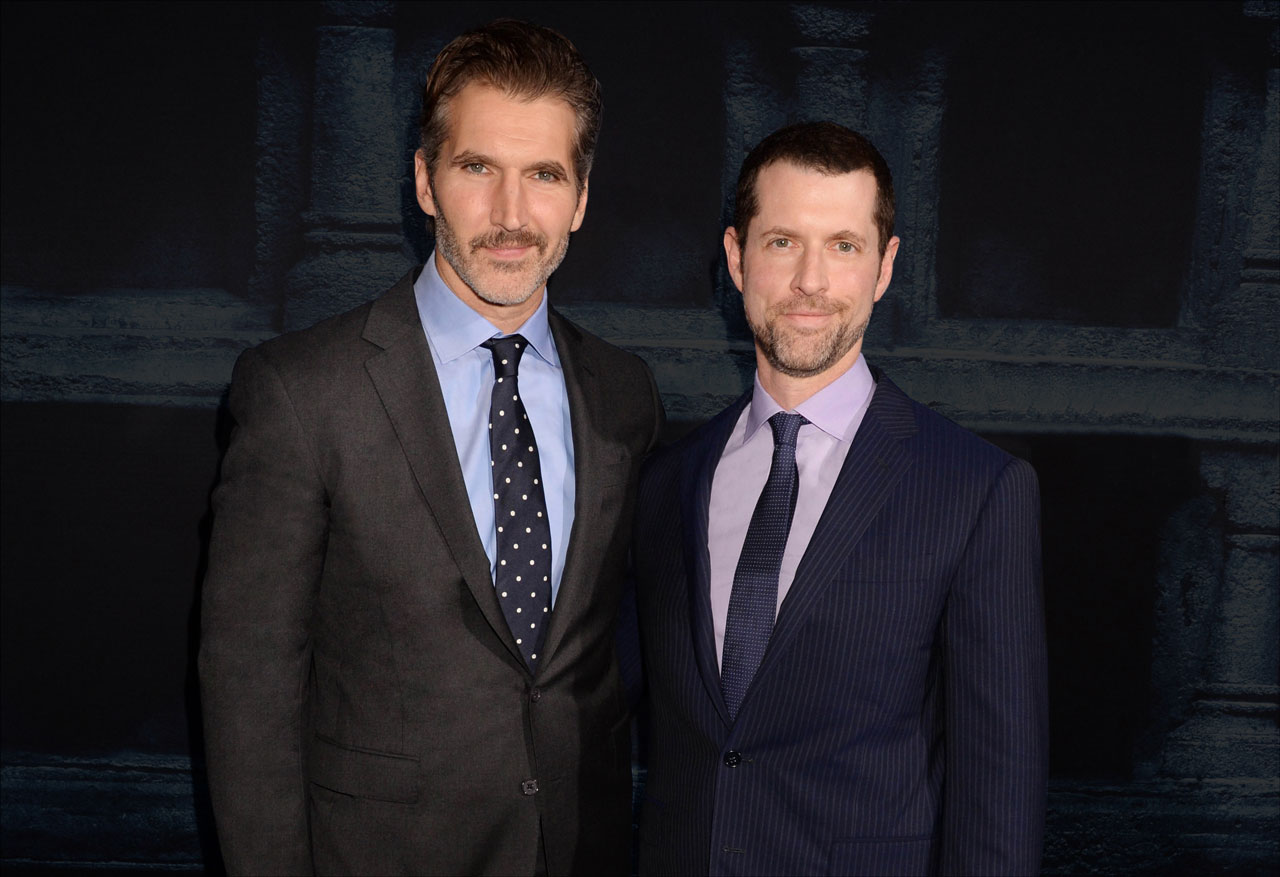
D.B. Weiss and David Benioff departed from their Star Wars film series.
On February 6, 2018, Lucasfilm announced that Game of Thrones series creators D.B. Weiss and David Benioff were set to write and create a Star Wars film series, and the two confirmed that they would begin work on the project once the eighth and final season of Game of Thrones aired. On August 15, Lucasfilm art director Neil Lamont revealed that a film that featured Tatooine was in development but was canceled. On February 10, 2019, it was reported that the film series was a trilogy, and that Benioff and Weiss were collaborating with The Last Jedi director Rian Johnson as he made his own Star Wars trilogy. On May 7, Disney announced that the next three Star Wars films would release in 2023, 2025, and 2027. On October 28, it was reported that Benioff and Weiss had exited the project to focus on new projects for Netflix.
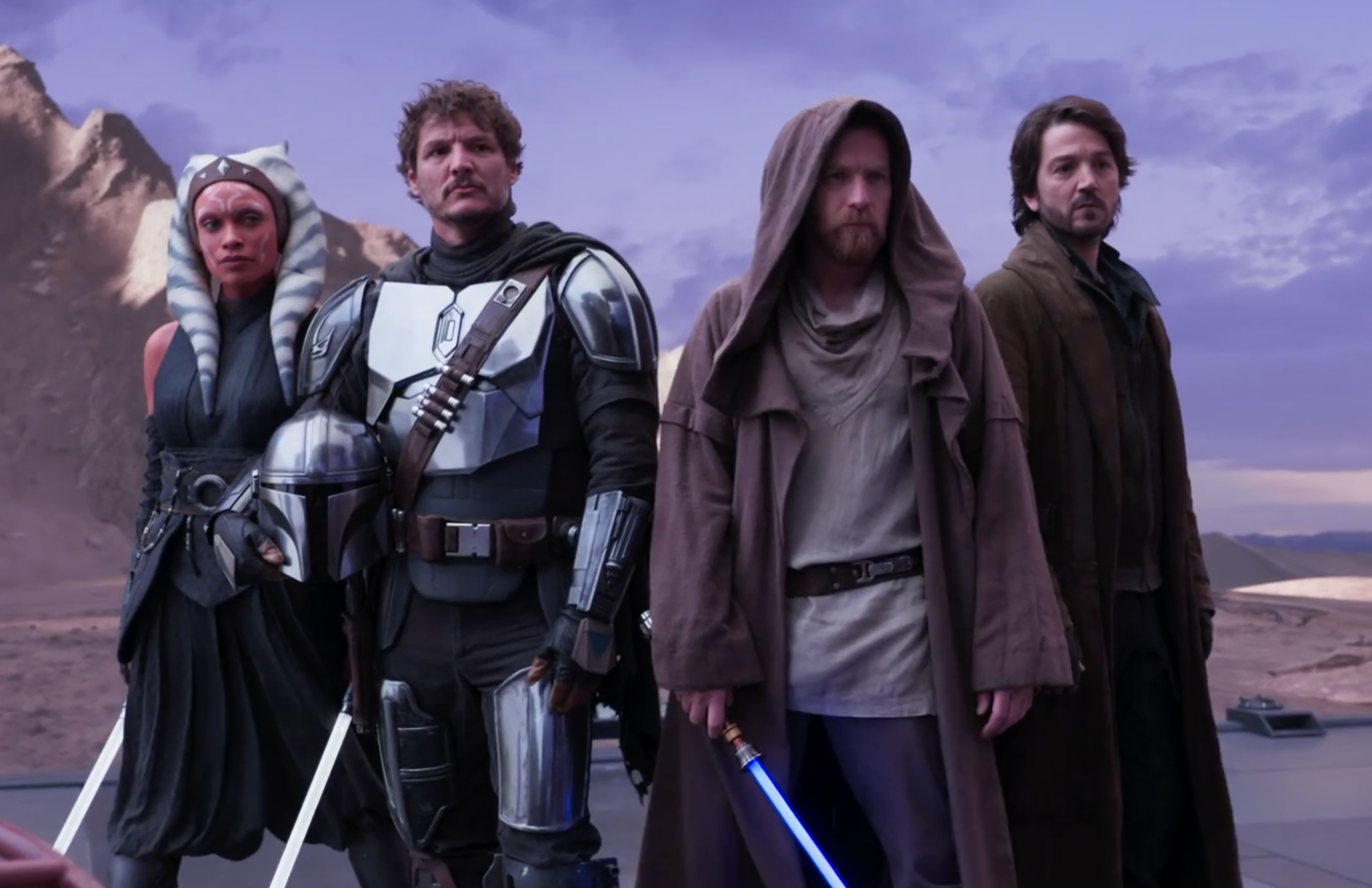
Star Wars reinvented itself by creating a number of live-action television series focusing on legendary and contemporary characters.
Prior to Disney's acquisition of Lucasfilm, George Lucas was developing Star Wars: Underworld, a live-action Star Wars series with a planned one hundred episodes. The level of quality that Lucas expected, however, proved to be too expensive to produce as a live-action series, and the series was abandoned in 2012. In 2017, Lucasfilm was tasked by Disney to make another attempt at producing live-action television series to bolster its upcoming Disney+ streaming service and compete with Netflix and Amazon Prime Video.
President Kathleen Kennedy's primary objective was to introduce a new era of films with the sequel trilogy. While the films earned billions at the box office, the fluctuating narrative was evident and led to what was known as "the hiatus," a gap in the Star Wars film planning which was announced in early 2019, months before the closing chapter of the sequel trilogy was released so that Lucasfilm could regroup. Kennedy stated that the company recognized that this time period was a new chapter for the company, and that they all needed to work together to create the architecture for the future. With the Star Wars anthology films, Lucasfilm had been releasing one film per year, and so Kennedy dissolved the annual deadlines and wanted to reconsider objectives. Kennedy believed that Star Wars required a greater degree of professional devotion from filmmakers. Kennedy remarked that anyone who went into the Star Wars universe needed to understand that it was a three to five year commitment, and that it required nurturing. Kennedy felt that in order to prepare for Disney+, their series had to feel as large as the films. As a result Kennedy turned to Jon Favreau.
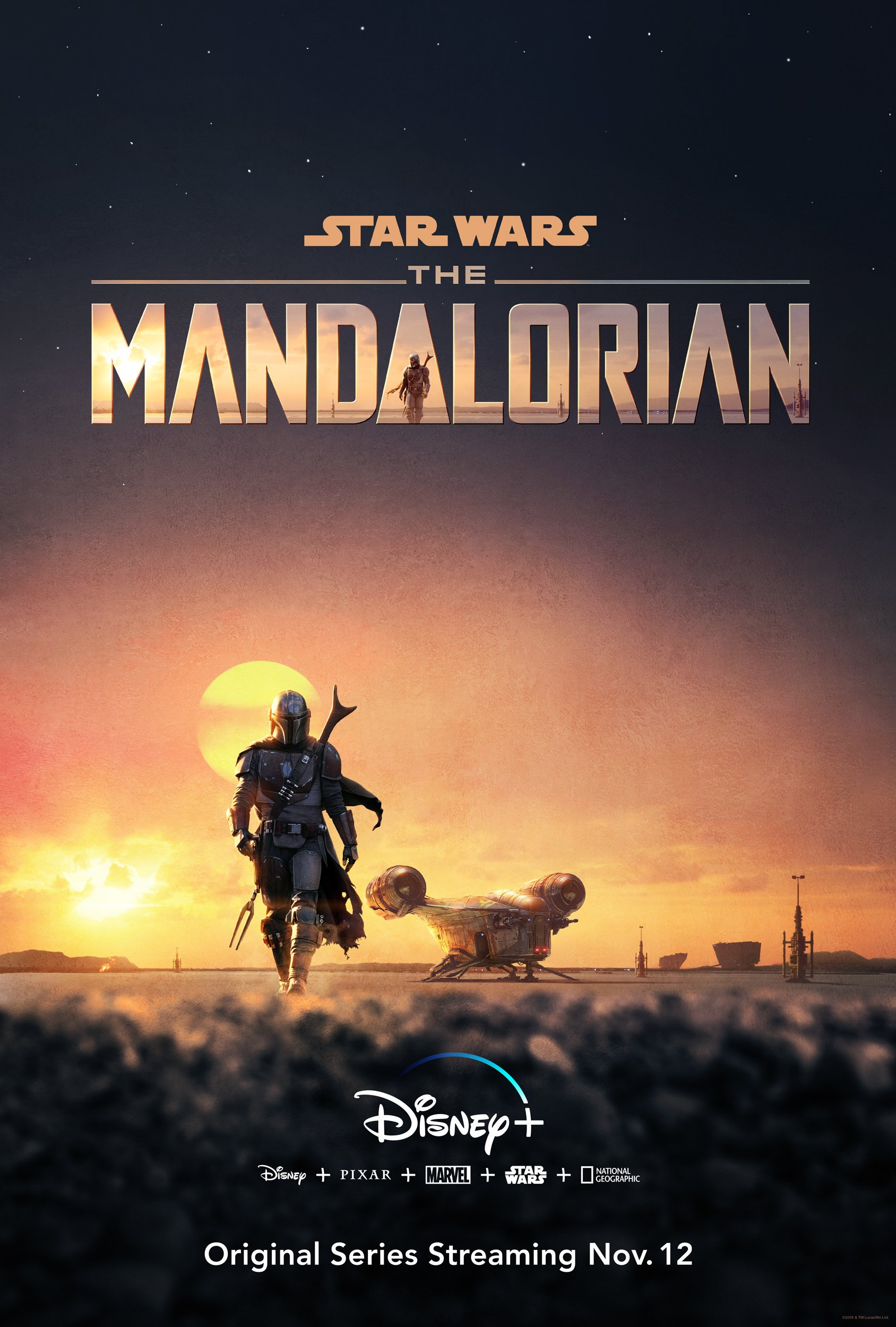
The Mandalorian heralded a new age for Star Wars and Lucasfilm.
Favreau, who had worked with Disney on the ground-breaking visual effects films The Jungle Book and The Lion King, was always deeply interested in Star Wars as understood by Kennedy. Favreau had previously starred as a Mandalorian animated character in Star Wars: The Clone Wars. As a result, Favreau was the first person approached by Kennedy for this new era and demonstrated that not only was he interested, but he had an idea. For Kennedy, Favreau met the new criteria of hers, in that his sole focus was being committed to Star Wars. After meeting in Kennedy's office, Favreau began work without even having a contract in place and by the time he was hired he had already written the first four episodes for his series centered around a lone gunslinging Mandalorian. At the same time, Lucasfilm executive Dave Filoni approached Kennedy, and wanted a series focused on the Mandalorians as he wanted to explore some of the ideas that were never fully realized when developing The Clone Wars with George Lucas. Filoni began playing a critical role in Lucasfilm's new TV strategies, was indispensable as he channeled George Lucas, and Kennedy had been nurturing his filmmaking ambitions ever since she arrived in 2012.
Although Favreau and Filoni were friendly, Kennedy feared that a conflict may rise and arranged a meeting between the two. The two got along instantly, with both exchanging ideas and drawings for a Mandalorian show that could combine their ideas. Filoni's knowledge of Mandalorian history mixed well with the lone gunslinger idea Favreau wanted to develop. They also challenged each other, with Favreau's idea for the Child, Grogu, being the biggest contention. That gave development some pause, with Filoni having reservations and sketches and concept being created. There were many looks, until Christian Alzmann's sketch made everything click. Additionally, Industrial Light & Magic developed the "Volume" in 2018, which is a large curved LED wall that can envelop a film crew in a photorealistic digital environment.
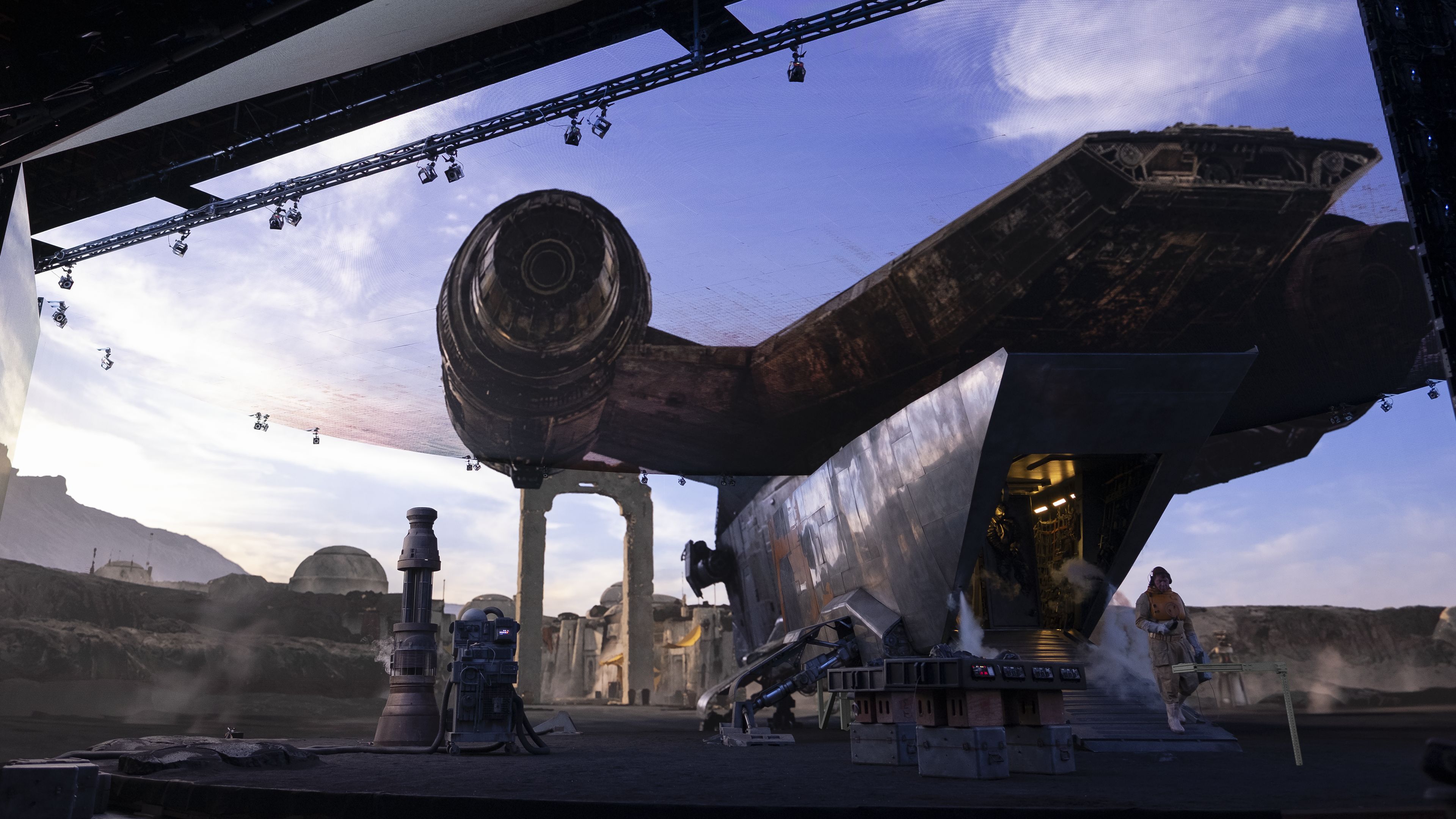
The "Volume," developed by ILM for The Mandalorian, revolutionized filmmaking technology for the entire industry.
The technology was unsteady, but was further refined and in spring of 2018, legendary filmmaker James Cameron visited as he was working on the Avatar sequels nearby. Favreau had the team display on the monitors the test shot done earlier. Cameron approached the Volume and approved of how convincing it was. The Volume allowed Lucasfilm to produce The Mandalorian in a better cost-effective method, and in half the time of a Star Wars or Marvel film. The Mandalorian debuted in November 12, 2019 to critical and commercial success, and further seasons were planned. It was one of the most-watched series in 2019, and received many accolades, being nominated for fifteen Emmy Awards and winning seven. The second season debuted in October 30, 2020 and was nominated for twenty-four Emmy Awards, winning seven. The third season debuted on March 1, 2023.
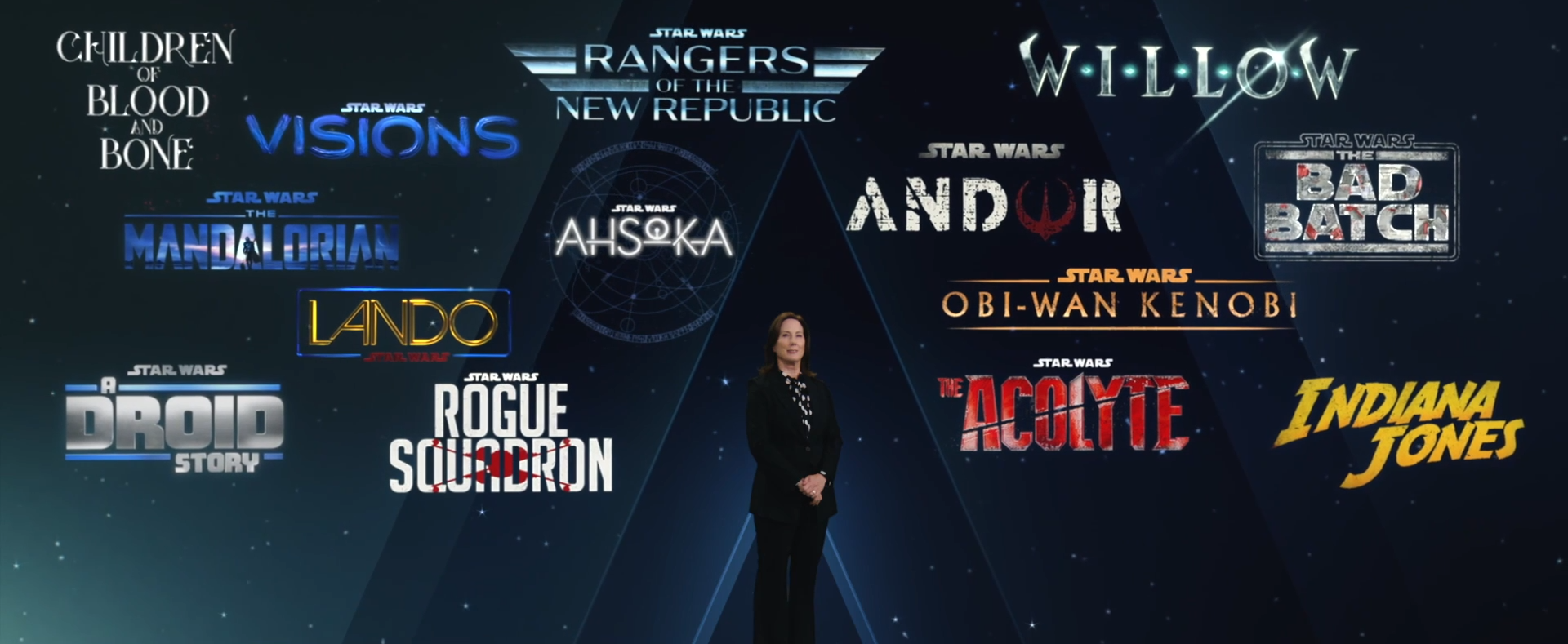
Lucasfilm's future projects as of 2020, including eleven new Star Wars projects.
Prior to the launch of The Mandalorian in November 2019, Lucasfilm revealed at the D23 Expo Event in July 2019 that the company was creating Obi-Wan Kenobi, a live-action TV series starring Ewan McGregor returning as Jedi Master Obi-Wan Kenobi following the events of Revenge of the Sith. In February 21, 2020, The Final Season of Star Wars: The Clone Wars premiered on Disney+ with twelve episodes culminating in the finale's release on May 4.
Guillermo del Toro had a Star Wars film in production about Jabba the Hutt's rise to power, but it was eventually cancelled. Announced in Star Wars Celebration Chicago as Project Luminous, Star Wars: The High Republic was revealed in early February 24, 2020 as an expansive multi-media project, spanning novels, comics, audio plays and more, establishing and expanding the High Republic Era set before the events of the prequel films. Split into three phases with three waves each, The High Republic encompasses dozens of story-telling material. A new animated spin-off series of The Clone Wars, Star Wars: The Bad Batch, was announced on July 13, 2020.
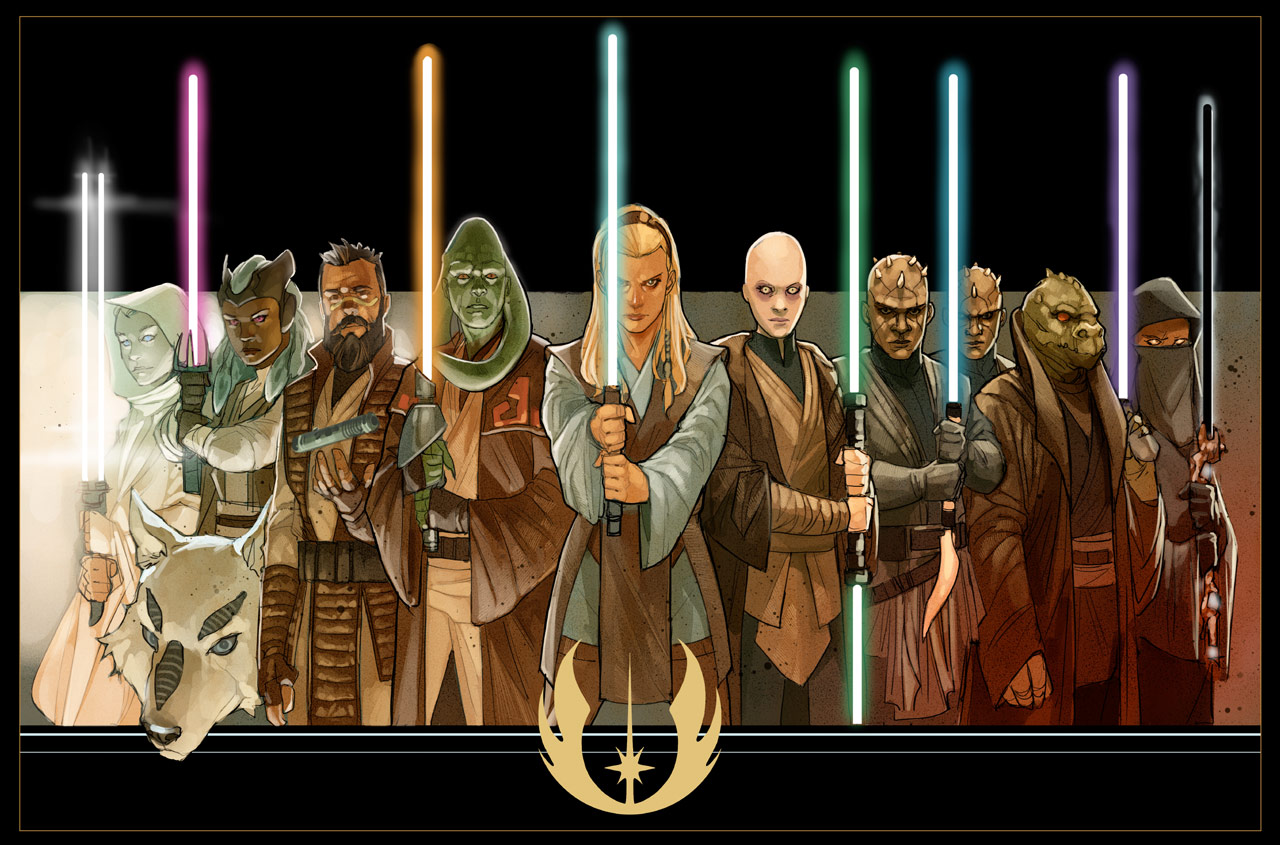
Star Wars: The High Republic introduced a new era in Star Wars that served as the renaissance period of the timeline.
Following the success of The Mandalorian and in the midst of The Mandalorian Seasons Two's release, Disney held the Disney Investor's Day 2020 event on December 10, showcasing the various future projects across the entire company. Kennedy helmed the section on Lucasfilm for the presentation, revealing a slew of new live-action and animated projects, both films and series. Kennedy announced The Mandalorian spin off series Rangers of the New Republic and Ahsoka, The Acolyte, Lando, A Droid Story, Star Wars: Visions, Rogue Squadron, and a film by Taika Waititi. Only eight days after the Investor's Day event on December 18, the finale of the second season of The Mandalorian revealed The Book of Boba Fett, the next chapter in the realm of The Mandalorian stories.
Star Wars: The Bad Batch premiered on May 4, 2021 with the hour-long episode "Aftermath." Starting a season of sixteen episodes, the series focused on Clone Force 99 during the fall of the Galactic Republic and the rise of the Galactic Empire. On August 5, a second season of The Bad Batch was confirmed. Later that same year on September 22, Star Wars: Visions premiered with nine short anime films, the first Star Wars project in an anime format.

Boba Fett's return and rise to a crime lord was explored in The Book of Boba Fett
The Book of Boba Fett released on December 29, 2021, and was centered on the legendary bounty hunter Boba Fett. Initially, prior to The Mandalorian, Lucasfilm planned to feature the bounty hunter in a feature film developed by James Mangold, yet the film was put on hold. Eventually, Favreau and Filoni picked up Boba Fett's story, officially reintroducing the titular bounty hunter in "Chapter 9: The Marshal" and fully in "Chapter 14: The Tragedy," with the latter episode directed by Robert Rodriguez.
Pleased with Rodriguez's direction on the episode, Favreau brought him on board to executive produce The Book of Boba Fett alongside himself and Filoni. Filming reportedly began by late November 2020, and brough titular characters such as Ahsoka Tano and Luke Skywalker, who had appeared in the second season of The Mandalorian.
In 2017, Obi-Wan Kenobi actor Ewan McGregor was invited to the El Capitan Theatre in Los Angeles for a screening of every Star Wars film. There, they asked McGregor if he would like to participate in introducing a new Star Wars film, and McGregor recalled that he suddenly felt that he really did want to continue being Kenobi. By this time, younger audiences who grew up with the prequel films enjoyed them, and McGregor found himself realizing that he enjoyed playing Obi-Wan. Around this time, McGregor was commonly asked if he would ever consider playing Obi-Wan Kenobi in interviews, which he always answered in the affirmative. In 2018, then Vice President of Development at Lucasfilm Kiri Hart asked McGregor if he was genuine and authentic, to which McGregor recalled that he would be happy to perform as Obi-Wan.
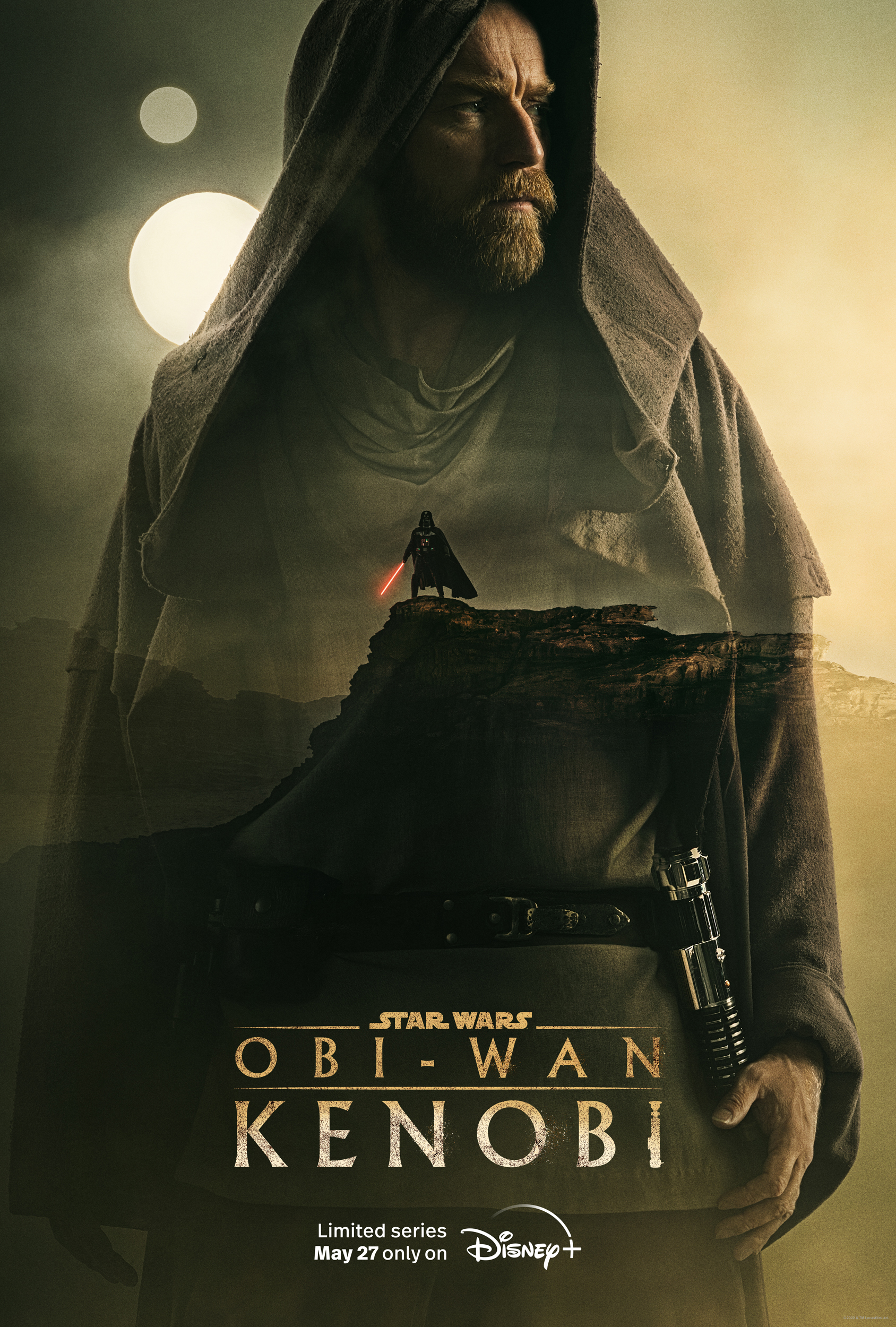
Obi-Wan Kenobi released in May 2022 on Disney+, and focused on the classic character.
At first, the project was to develop the new Obi-Wan Kenobi story as film, to be directed Stephen Daldry and McGregor executive producing. The film then transformed into an Obi-Wan TV series to serve as part of Lucasfilm's new initiatives for the Disney+ streaming service. At that time, Daldry departed and Deborah Chow, a director from The Mandalorian, joined the development for the series to keep it in authentically cinematic scope. In the early drafts of the story, Darth Vader was not included, which brought a common debate at Lucasfilm: How much should legacy characters be used and how much should they be kept in reserve? When developing the story, Lucasfilm debated whether introducing Vader to a story regarding Obi-Wan after Revenge of the Sith would take away from their meeting in A New Hope or if it would enhance that moment. Kenobi producer and Senior Vice President of Live Action Development and Production Michelle Rejwan stated that these discussions are always held.
In fall 2019, Director Chow visited Anakin Skywalker actor Hayden Christensen about returning to Star Wars as Vader, to which he eventually agreed. While Chow advocated for a rematch between Vader and Kenobi, reportedly at the behest of Dave Filoni, Lucasfilm's Story Group debated on whether to go that route. As a result, soundstages that were reserved in England were canceled, and the story was internally scrutinized further, resulting in fears from fans that the show may be canceled. In March 2020, the decision for Vader to return in Obi-Wan Kenobi was finalized.
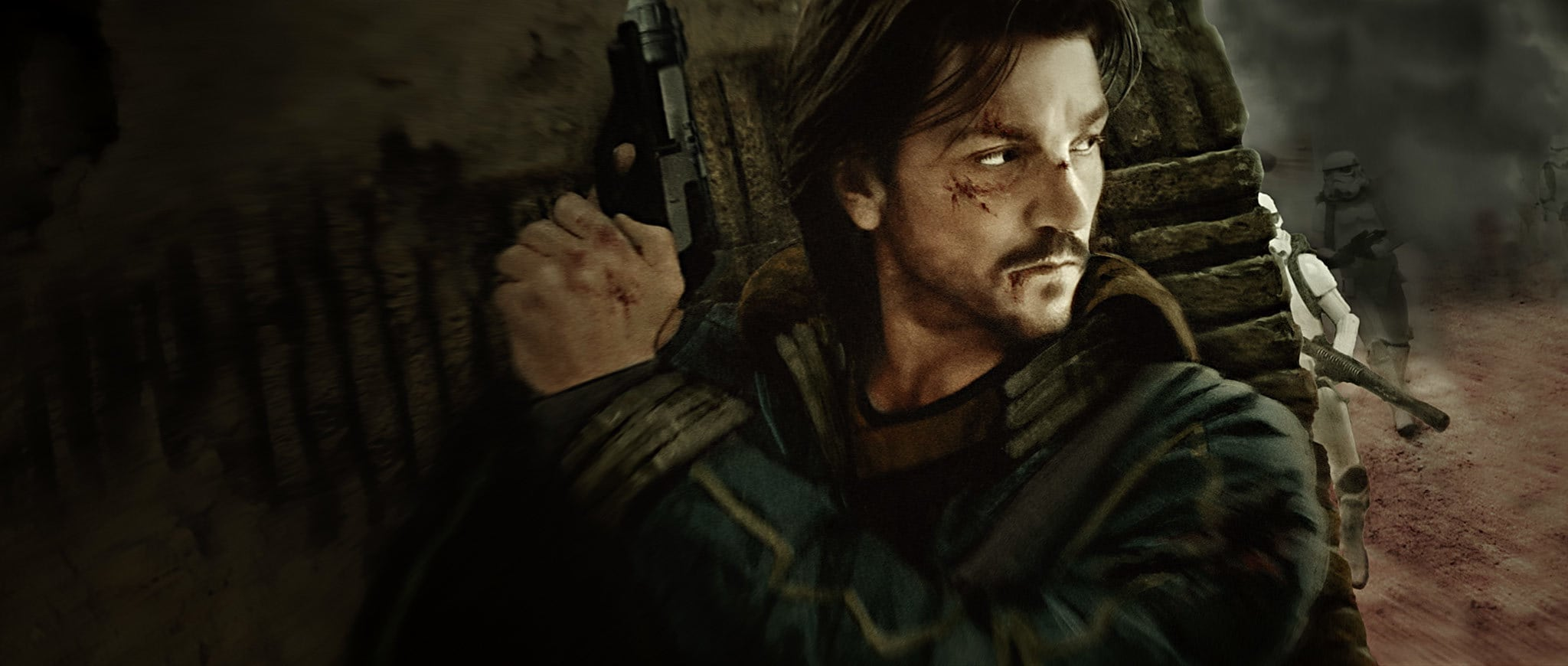
Andor explored the time of Andor before Rogue One: A Star Wars Story.
Around 2019, Rogue One actor Diego Luna, who played the Rebel Alliance spy captain Cassian Jeron Andor, received a call from Tony Gilroy, who modified Rogue Ones script for reshoots, while Luna was in Mexico City. There, Gilroy told Luna of his plans for a new series focusing on Andor. Officially revealed in Investor's Day 2020, Andor was initially confirmed in November 8, 2018. Filming in London was already underway by December 3, 2020 and wrapped in September 2021. The first season of Andor released at the end of summer in 2022, with production on the second season already underway by May of the same year.
Also announced in Investor's Day 2020 as a The Mandalorian spin-off series, Ahsoka premiered in August 2023. Revolving around the titular character introduced in The Clone Wars, Ahsoka Tano, the series was written and produced by Dave Filoni. Filoni created the character with George Lucas, and the series focuses on quest to hunt down Grand Admiral Thrawn following her live-action debut in The Mandalorian and later appearing in The Book of Boba Fett. Filoni stated that Star Wars: Ahsoka would be a continuous story that drove toward a goal rather than being singular episodic adventures. Filming for the series began in May 9, 2022.
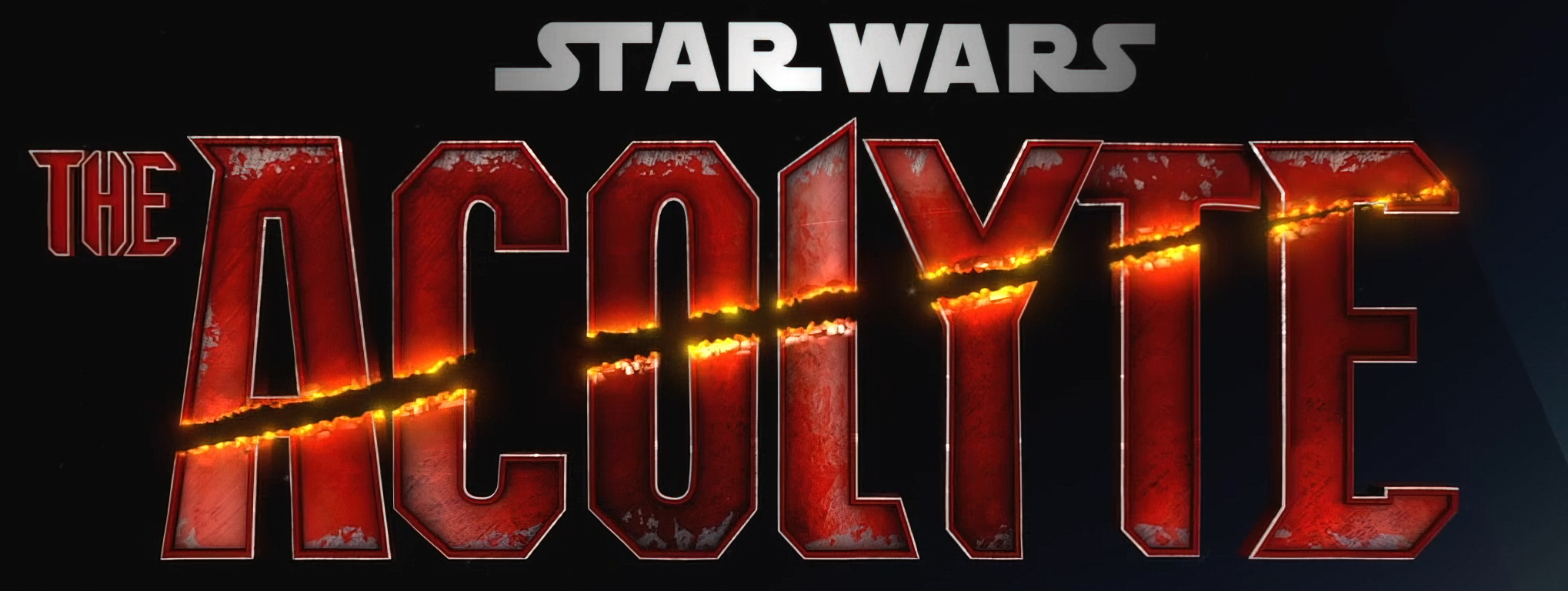
The Acolyte is one of multiple series in development.
With this new era of Star Wars, Lucasfilm will need new actors, characters, and epoch to expand on the current canon timeline. One of these new ventures is the mystery thriller The Acolyte, which is set in the new High Republic Era introduced by the Star Wars: The High Republic multimedia project. The Acolyte is in the casting phase of production as of May 2022, with the writing largely completed as confirmed by producer and creator Leslye Headland. Headland had been developing The Acolyte since 2020, prominently within her own home. Another new Star Wars series, under the production title "Grammar Rodeo," is also under development at Lucasfilm and is executive produced by Jon Watts and written by Christopher Ford. The series is described by Lucasfilm as a classic coming-of-age adventure. The Star Wars: Tales of the Jedi series of animated shorts was first announced on at Celebration Anaheim on April 27, 2022.
Celebration Anaheim commenced on May 26, starting a slew of new announcements and information. "Grammar Rodeo" was revealed to be Star Wars: Skeleton Crew, and Andor debuted its first teaser trailer. On May 27, Star Wars Jedi: Survivor was officially revealed, along with an accompanying teaser.
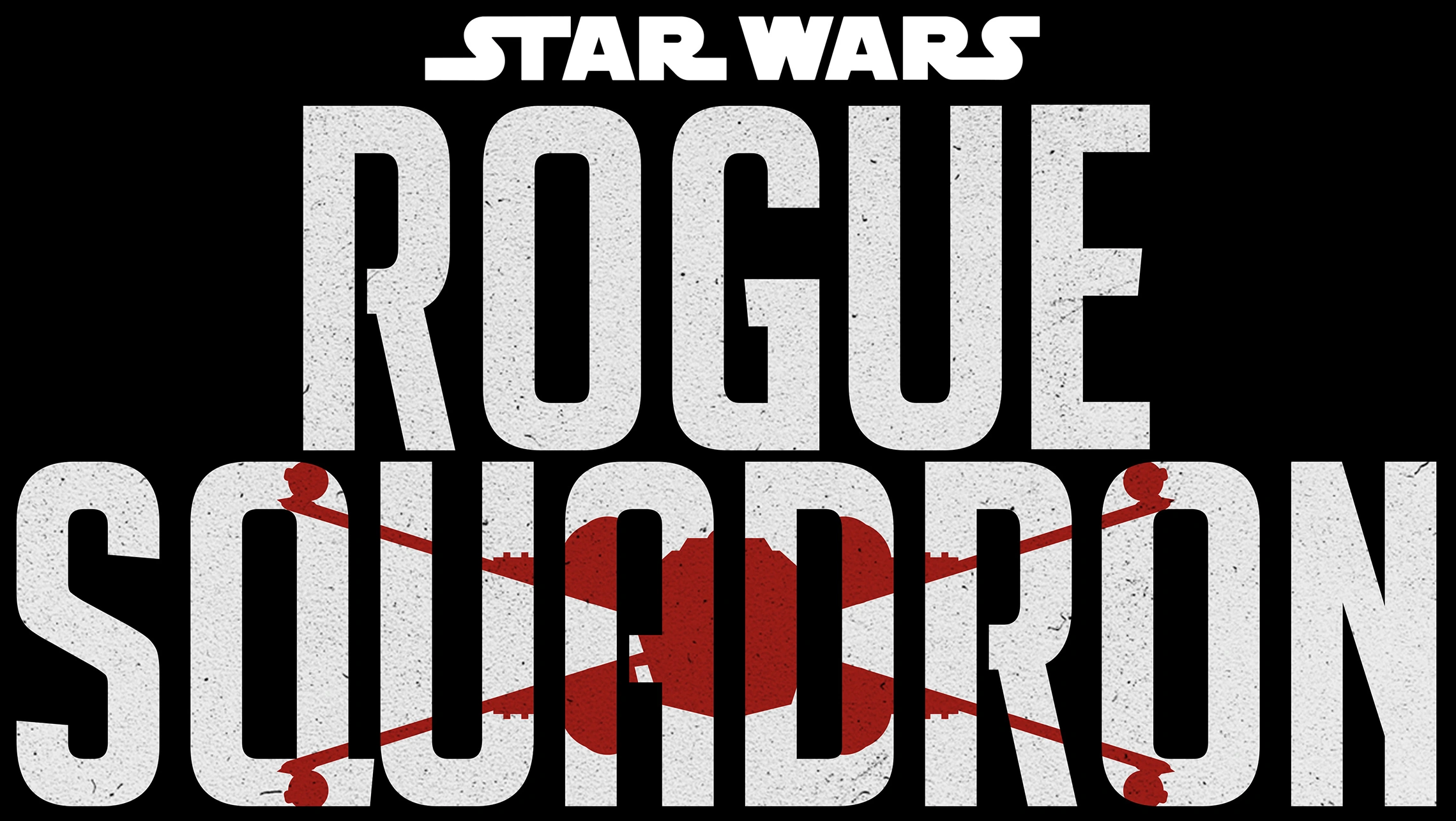
The upcoming film, Rogue Squadron
With Lucasfilm's pivot to TV series, the company's theatrical return may be unlikely to follow the relentless releases in the past. President Kathleen Kennedy remarked that the company had a road map for their theatrical projects, with Krysty Wilson-Cairns and Taika Waititi's Star Wars film likely being the first to launch, followed by Rogue Squadron from Patty Jenkins. In May 2022, Kathleen Kennedy confirmed in an interview with Vanity Fair, that Rogue Squadron had been pushed off to the side by Lucasfilm. Although a Star Wars film from Marvel CEO Kevin Feige was announced in October 2, 2019 Kennedy stated that there was no such project.
J.D. Dillard was reported to be working on a new Star Wars film in February 2020, but by November 8, 2022, he revealed that his Star Wars project was no longer in development. Additionally, the trilogy of Star Wars films from The Last Jedi director Rian Johnson has been prolonged, as Johnson continues to work on the multiple Knives Out films for Netflix. Kennedy noted that she's hesitant to use the word trilogies with Star Wars presently as the franchise was more about persistent storytellers, and that now she had to recruit feature filmmakers who shared her visions.
During Celebration Europe, on April 7, 2023, it was announced that three upcoming Star Wars films were in the works. One film will be directed by James Mangold, and will focus on the dawn of the Jedi, taking place before the events of The Phantom Menace. Another is directed by Dave Filoni, and will focus on the New Republic era, taking place between the events of Return of the Jedi and The Force Awakens, and will tie together the stories told in The Mandalorian, The Book of Boba Fett, and Ahsoka. The final film announced will be directed by Sharmeen Obaid-Chinoy, taking place after the events of The Rise of Skywalker, and will focus on Rey building a new Jedi Order.
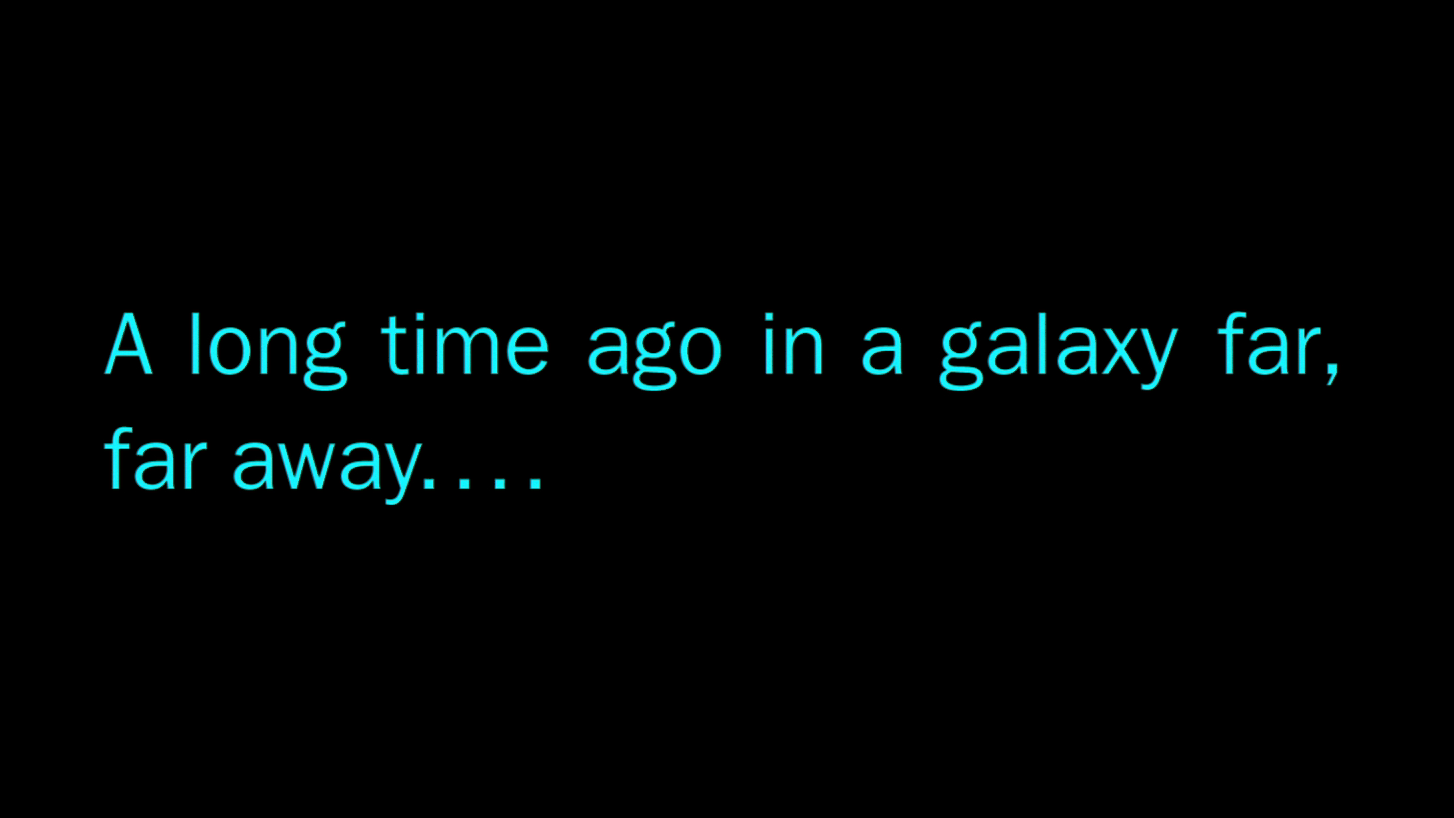
The introduction to every Star Wars film
The line "A long time ago in a galaxy far, far away.…," which appears at the beginning of every Star Wars film, and is the only way the Star Wars galaxy has been defined in relation to the real world. It is alluding to the classic fairy tale line "Once upon a time, in a land far, far away…" and variations thereof. It may reflect that the films are to be interpreted as the myths of the future, as opposed to literally meaning that the events take place in the past. Lucas himself intentionally left the details open to interpretation.
The saga shows an "ancient" galactic civilization thousands of years old. The setting is totally unrelated to Earth, the Milky Way Galaxy or reality, which gives it more liberty, in a sense. The Star Wars galaxy prominently features humans that look like those from Earth. Their civilization was able to develop space travel, terraform, build ecumenopoleis, and build space colonies 200,000 years "ago," according to the Expanded Universe.
The titular Star Wars originally referred to the Galactic Civil War which takes place in the original trilogy. However, when considering the prequels (focusing on the Invasion of Naboo and the Clone Wars), the sequels (depicting the First Order-Resistance War) and the Expanded Universe, these events are only a portion of the millennia-spanning war between the Sith and the Jedi/Galactic Republic.
Star Wars also merges science with supernatural elements that strongly relate to epic stories and fairy tales (e.g., magic, knights, witches, princes, and "whimsical" alien races such as Ewoks, Wisties, etc.).
While the scope of Star Wars history spans many thousands of years among all of the Star Wars history recorded and over 36,100 years in all the fiction produced to date (from Dawn of the Jedi to Star Wars: Legacy), the films span only two generations.
Later novels from a series dubbed The New Jedi Order opened up the Star Wars setting with alien beings known as the Yuuzhan Vong that came from a different galaxy, much to the surprise of some fans. Nearly all species and events prior to this series considered only one single galaxy.
A version of the Star Wars logo
The original idea for Star Wars was conceived in the early 1970s and went through many revisions, providing plenty of material for the films. The original Star Wars movie (Episode IV) was first released in 1977, but the novelization was released six months earlier, in 1976. The sixth Star Wars film (Episode III) was released in 2005. There were originally to be nine films in three trilogies (some accounts claim twelve films in four trilogies); however, Lucas has stated that he does not intend to make any more Star Wars films after Episode III.
On October 30, 2012, The Walt Disney Company, along with the announcement of the acquisition of Lucasfilm, announced plans for the production of a new series of films, beginning with Star Wars: Episode VII The Force Awakens in 2015, and plans for additional films. George Lucas announced he would not be directing the films but would serve as a creative consultant.
All of the original films were shot at, among other locations, Elstree Studios. Episode I was filmed at Leavesden Studios and the subsequent prequels were filmed in Sydney, Australia. Tunisia has served as the location for filming scenes set on the desert planet Tatooine.
Together, the first nine movies in the main saga have made a grand total of $8,789,255,249 worldwide at the box office. An eighth film has been released in 2017, titled Star Wars: Episode VIII The Last Jedi, as well as a ninth, Star Wars: Episode IX The Rise of Skywalker.
Films by release order:
George Lucas has tinkered repeatedly with the original trilogy. For the Special Editions of Episodes IV through VI, the films were extensively cleaned up and restored, and Lucas took this opportunity to make a number of changes, adding previously cut scenes and new effects. The Special Editions were released in theaters in early 1997, and on VHS later that year. Further changes were made for the films' initial DVD release in September 2004. In 2006, Lucas finally released the original trilogy in unaltered form on DVD.
At a ShoWest convention in 2005, George Lucas demonstrated new technology and stated that he was planning to release all six films in a new 3D film format, beginning with A New Hope in 2007. This did not materialize, but on September 28, 2010, StarWars.com announced the 3D release of Star Wars: Episode I The Phantom Menace coming to theaters in 2012.
Lucas also hinted in the past that he would release his definitive, often called "archival," editions of all six Star Wars films in one set on a next-generation home-video format in 2007. This release was to coincide with, and celebrate, the 30th anniversary of the Star Wars saga. These "archival" editions were never released, or announced.
Despite the Disney's 2012 purchase of Lucasfilm Ltd. and the release rights to all future Star Wars films, Fox was to retain original distribution rights to A New Hope, which they co-produced and co-financed, in perpetuity in all media worldwide. Fox was also to retain theatrical, nontheatrical, and home video rights worldwide for the franchise's five subsequent films, which Lucasfilm produced and financed independently, through May 2020, at which time ownership was to transfer to Disney. This complex relationship between Fox and Disney, particularly in regards to Fox's perpetual rights to Episode IV, was to create an obstacle for any future boxed set comprising all nine films. On December 14, 2017, the Walt Disney Company announced that it is acquiring most of Fox's parent company, 21st Century Fox, including the film studio and all distribution rights to A New Hope.
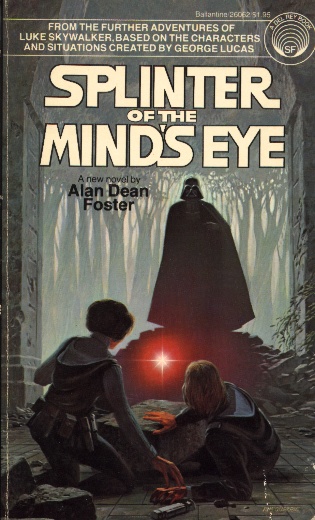
Splinter of the Mind's Eye
The Expanded Universe (or EU) is the continuation of the movies. It plays a major role in the storyline. One can read books from the prequel era, between the movies, or post-Episode VI. There are also several books dealing with the lives of Han Solo and Lando Calrissian just before the movies. There are even books about the briefly shown Wedge Antilles. Some notable characters within the EU include the twins Jaina and Jacen Solo, former Emperor's Hand Mara Jade, the pilot-turned-Jedi Corran Horn, and the tactical genius Grand Admiral Thrawn.
The books set during or after the Star Wars original trilogy follow Luke Skywalker, Princess Leia, Han Solo, and other minor characters, as well as the growth of the New Republic. The Truce at Bakura by Kathy Tyers is the first book chronologically set after Return of the Jedi, but the first Expanded Universe story written was Alan Dean Foster's Splinter of the Mind's Eye.
Writers in the Expanded Universe often gave context to details in the movies, for example explaining that the absence of non-humans shown in the Galactic Empire (compared to the numbers in the Rebellion) was because most Imperials were xenophobic.
The earliest Expanded Universe stories chronologically are those in Dawn of the Jedi. Novels such as the Darth Bane Trilogy, The Old Republic: Revan, and Knight Errant feature both the Galactic Republic and the Jedi Order thousands of years before the rise of the Galactic Empire.
Thousands of years later, series about the training of Obi-Wan Kenobi and the Naboo Crisis introduce the characters and situations that form the backbone of the story told in the films. The story then revolves around the Skywalker family and their friends and adversaries. The Skywalkers are involved in every important event from that point forward. They go through numerous wars, the last known being Cade Skywalker and the Second Imperial Civil War.
Star Wars, the NPR radio adaptation (1981), was followed by adaptations of the next two films of the series. These adaptations were written by science-fiction author Brian Daley, who also wrote three novels detailing the adventures of Han Solo and Chewbacca prior to their appearance in Star Wars: Episode IV A New Hope.
There are six official feature-length works besides the primary films of the three trilogies:
- The Star Wars Holiday Special (1978)
- Caravan of Courage: An Ewok Adventure (1984)
- Ewoks: The Battle for Endor (1985)
- Star Wars: The Clone Wars (2008)
- Rogue One: A Star Wars Story (2016)
- Solo: A Star Wars Story (2018)
The first three of these are live-action, and were originally made for TV, though the 1984 Ewok film was shown in theaters in some locations outside the U.S. Star Wars: The Clone Wars is an animated theatrical feature kicking off the 2008 TV series. Rogue One and Solo are live-action standalone films.
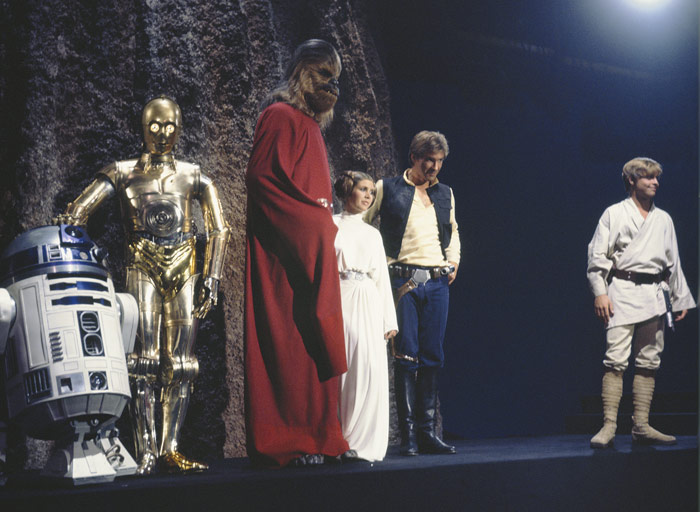
Chewbacca, along with Luke, Leia, Han, and the droids, celebrates Life Day by the Tree of Life in The Star Wars Holiday Special.
The Star Wars Holiday Special became famous for featuring Boba Fett's first appearance. An originally minor detail, the Wookiee food wookiee-ookiees became a cult symbol in the Star Wars fan universe, spawning plays on its name such as wookiee-cookiees (a Star Wars–themed dessert).
The term "Wookiee hooky" was used by media to reference high absenteeism to see a recently released Star Wars film.
Additionally, other filmmakers with no connection to Lucasfilm have made films that salute, document, parody, or unofficially extend Star Wars.
Mel Brooks' Spaceballs (1987) parodies Star Wars and some other science-fiction works.
The Official Star Wars Fan Film Awards is a Lucasfilm-sponsored contest of short films made by Star Wars fans about, referencing, and parodying the Star Wars phenomenon.
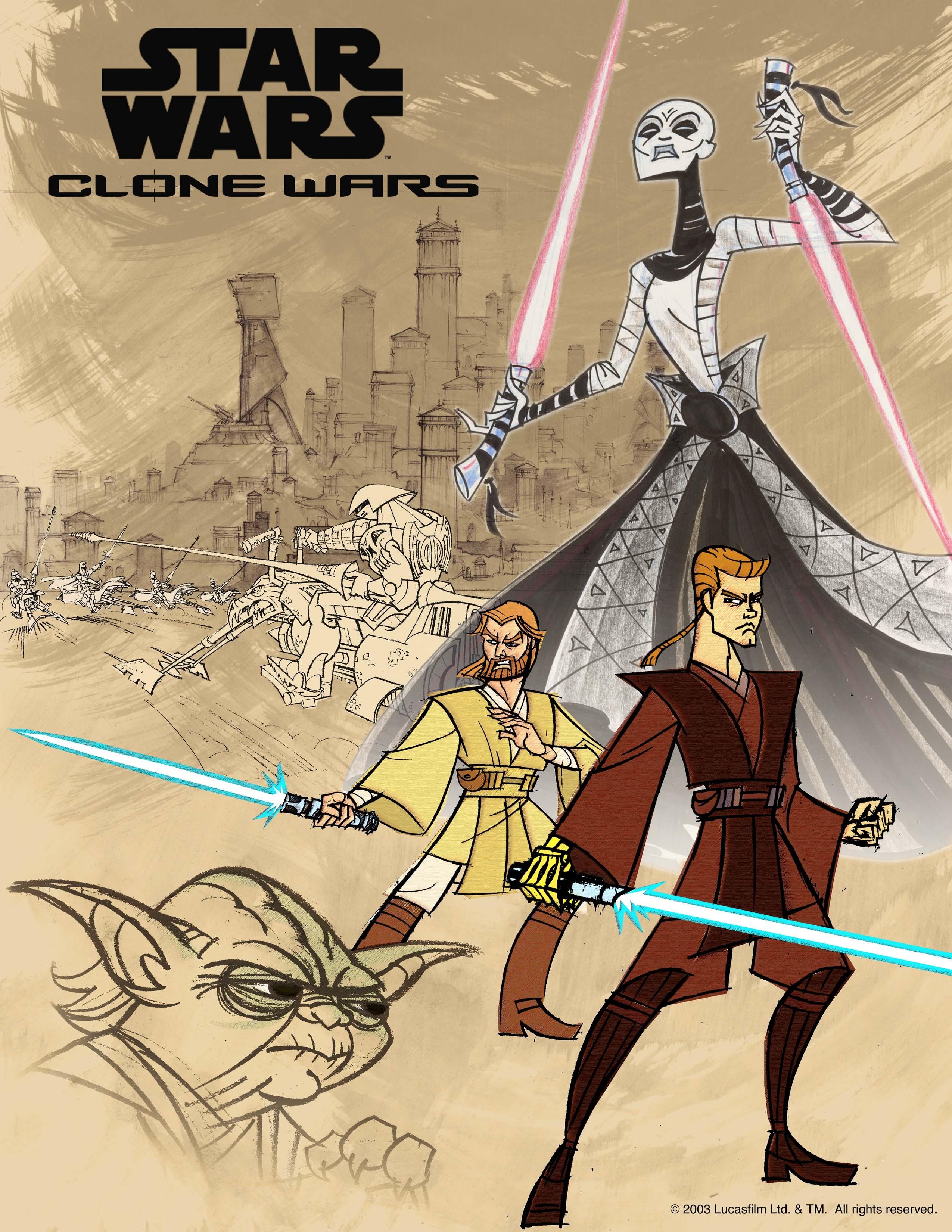
Star Wars: Clone Wars television series official poster
Animation formed another component Star Wars. The first two began in 1985, Clone Wars in 2003, The Clone Wars in 2008, and Rebels in 2014. Ewoks featured the adventures of the Ewoks prior to Return of the Jedi. Droids featured the adventures of C-3PO and R2-D2 between Star Wars: Episode III Revenge of the Sith and A New Hope.
In 1984 and 1985, George Lucas executive produced two live-action television episodes of a short series called Ewok Adventures. These take place before the Battle of Endor and follow the brief adventures of the Towani family after they are marooned on Endor. The two episodes were named Caravan of Courage: An Ewok Adventure and Ewoks: The Battle for Endor, and Warwick Davis returned to once again play the plucky Ewok Wicket W. Warrick. One odd thing in this series was that Wicket was taught to speak English, an ability he did not reveal at all during Return of the Jedi.
On November 9, 2017, Disney chairman Bob Iger revealed that a new live-action Star Wars television series, The Mandalorian, was to be released on Disney, its new streaming service set to launch in 2019.
Alongside The Mandalorian, there are also several other Star Wars television projects in development for Disney+, including the television series Obi-Wan Kenobi, Andor, and The Acolyte by Leslye Headland, the creator of Russian Doll.
Star Wars–based fiction predates the release of the first movie, with the novelization of A New Hope (by Alan Dean Foster but credited to George Lucas) released some months before the film itself. Foster also wrote the first original Star Wars novel, Splinter of the Mind's Eye, the 1978 publication of which inaugurated a very successful literary spin-off franchise.
The six Star Wars movies have provided a basis for over a hundred novels. The novels have been authorized by Lucasfilm, and were previously published by Bantam Books (with a few early titles published by Ballantine), though Del Rey now holds the contract again. The stories told in these books reach back thousands of years before The Phantom Menace to several generations after Return of the Jedi. Books authorized by Lucas are written by fans of the films, and are part of a collection known as Expanded Universe. The first books considered to be part of the Expanded Universe began to appear in the late 1970s.
Most of the novels that have been written take place after the events of the films, with a few that take place between the movies, and a growing number set before the films. For some fans, these can be more exciting stories, as they provide narratives for many characters who only have a minor roles, or are only briefly seen, in the movies. One of particular note is Steve Perry's Shadows of the Empire, which is set between The Empire Strikes Back and Return of the Jedi. In addition to focusing on relatively minor characters, it bridges some events between the two films.
Also, a few elements first introduced in the Expanded Universe were later included in the films. Such include Coruscant and Aayla Secura.
Aside from books providing narratives, there are also reference books which detail things about the Star Wars universe in a nonfiction style, revealing details that cannot fit into a story. Examples include The Wildlife of Star Wars: A Field Guide, Inside the Worlds of, and the Visual Dictionaries.
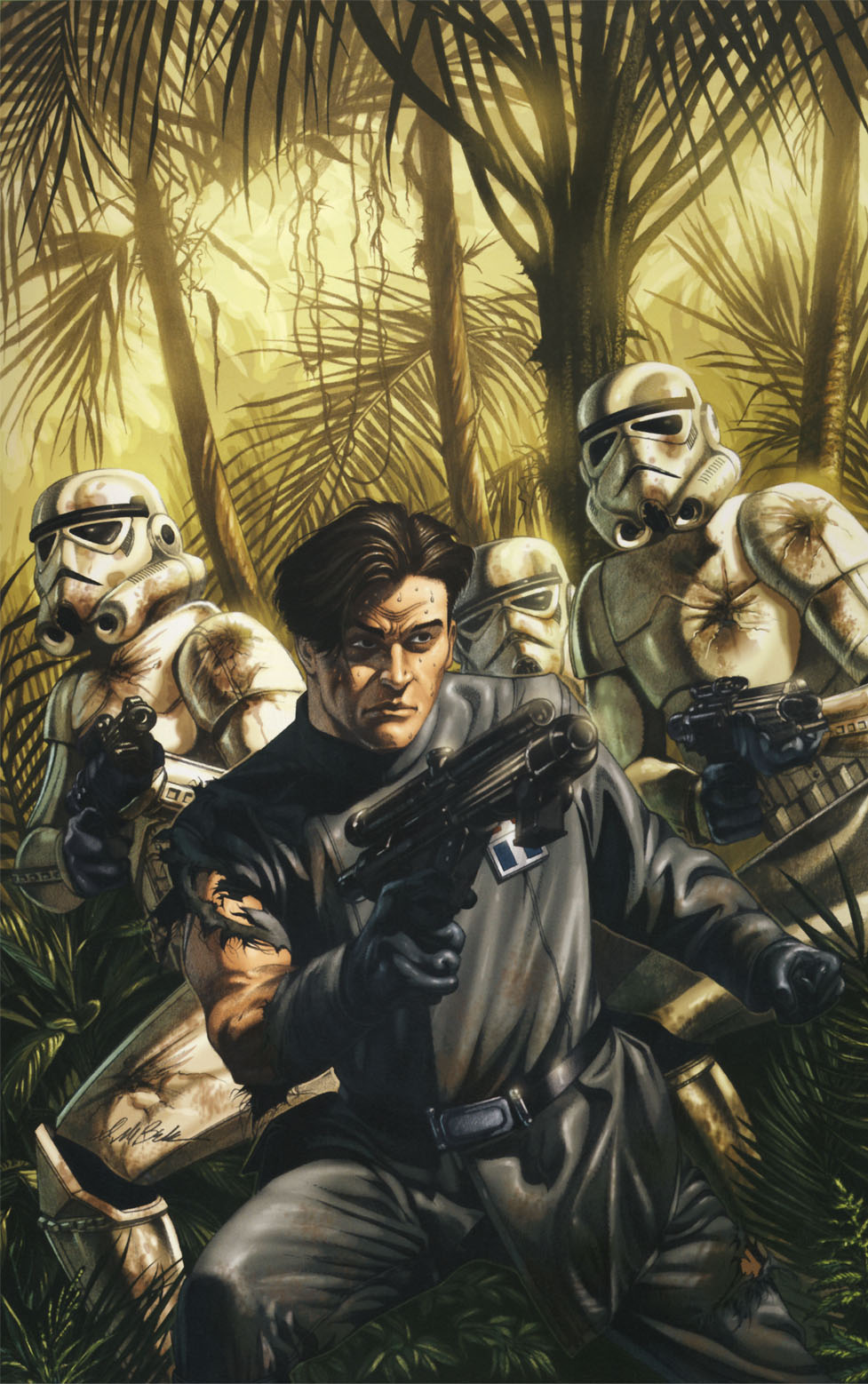
Star Wars: Empire to the Last Man cover
Marvel Comics published adaptations of the original trilogy as well as a Star Wars comic book series which lasted from 1977 to 1986, a total of 107 issues and 3 annuals. A wide variety of creators worked on this series, including Archie Goodwin, Howard Chaykin, Al Williamson, Carmine Infantino, Walter Simonson, Michael Golden, Chris Claremont, Whilce Portacio, Mary Jo Duffy, and Ron Frenz. In the 1980s, as part of their Star Comics line oriented towards young children, Marvel also published the short-lived series Ewoks and Droids, based on the Saturday-morning cartoons.
Star Wars was also a daily newspaper comic strip from 1979 to 1984, written for the bulk of its run by Archie Goodwin and drawn by Al Williamson.
Beginning in the 1990s, Dark Horse Comics has published a large number of original adventures set in the Star Wars universe. As of 2006, these mainly include Star Wars: Republic, Star Wars: Empire, Star Wars Tales, Star Wars: Jedi, Star Wars: Knights of the Old Republic, and Star Wars: Legacy. Dark Horse has also published collections of the Marvel series in seven volumes and the comic strip as Classic Star Wars.
Since 1983, over 120 video games have been published bearing the name of Star Wars, beginning with Star Wars: The Empire Strikes Back, published for the Atari 2600 by Parker Brothers.
The first games based on the franchise were released on the Atari 2600. In the first, The Empire Strikes Back (1982), the player drove a snowspeeder during the Battle of Hoth, destroying AT-AT walkers. While simplistic, the game captured the essence of the movie as well as technology allowed. Several other games appeared, like Return of the Jedi: Death Star Battle (1982), where the player controlled the Millennium Falcon in a mission to destroy the second Death Star, and Jedi Arena (1983), the first game to attempt to simulate a lightsaber battle (in this case, clearly inspired by the scene in A New Hope, where Luke Skywalker trains with a seeker). Also in 1983, Star Wars was released, based on A New Hope. In this game the player takes on the role of Luke Skywalker towards the end of the film in which Luke battles through many TIE fighters in an attempt to destroy the first Death Star.
Due to the video-game crash of 1983, which killed the home-console market, no further games based on the franchise were released until 1991, when the platformer Star Wars was released for both the NES and Game Boy, and one year later, Star Wars: The Empire Strikes Back reused the engine with the plotline of the fifth episode of the saga. It would be still in 1992 that Super Star Wars was released for the SNES (the Super prefix was often used in remakes of 8-bit games), followed by the remaining games in the trilogy: Super Star Wars: Empire Strikes Back (1993) and Super Star Wars: Return of Jedi (1994).
Other early titles include the game Star Wars for the Nintendo Entertainment System (published by JVC) and three other titles for the Atari 2600.
Video game pioneer Atari produced arcade games based on the original trilogy, beginning with Star Wars and The Empire Strikes Back, which were both flight-simulator-style games that utilized vector graphics. The third, Return of the Jedi, used more traditional raster graphics and a "3/4" perspective.
Star Wars: X-Wing (1993) was the first PC game of the "new generation" of games released by LucasArts. It returns to the space-fighter combat gameplay not seen since the Atari arcade games. Players generally played as a pilot for the Rebel Alliance, completing a variety of goals, culminating in the destruction of the Death Star. This game had sequels, in the form of Star Wars: TIE Fighter and Star Wars: X-Wing Alliance.
The longest running series of computer games is the groundbreaking Dark Forces series. This first person shooter series began in 1995 with Star Wars: Dark Forces. The next in the series was Star Wars: Jedi Knight: Dark Forces II, which allowed the player to play as a Jedi. The third game in the Dark Forces series, Star Wars: Jedi Knight II: Jedi Outcast, focused more on a third-person Jedi adventure than the previous games. And the fourth and last release was Star Wars: Jedi Knight: Jedi Academy, which originated as an expansion pack for Jedi Outcast, but evolved into a game of its own.
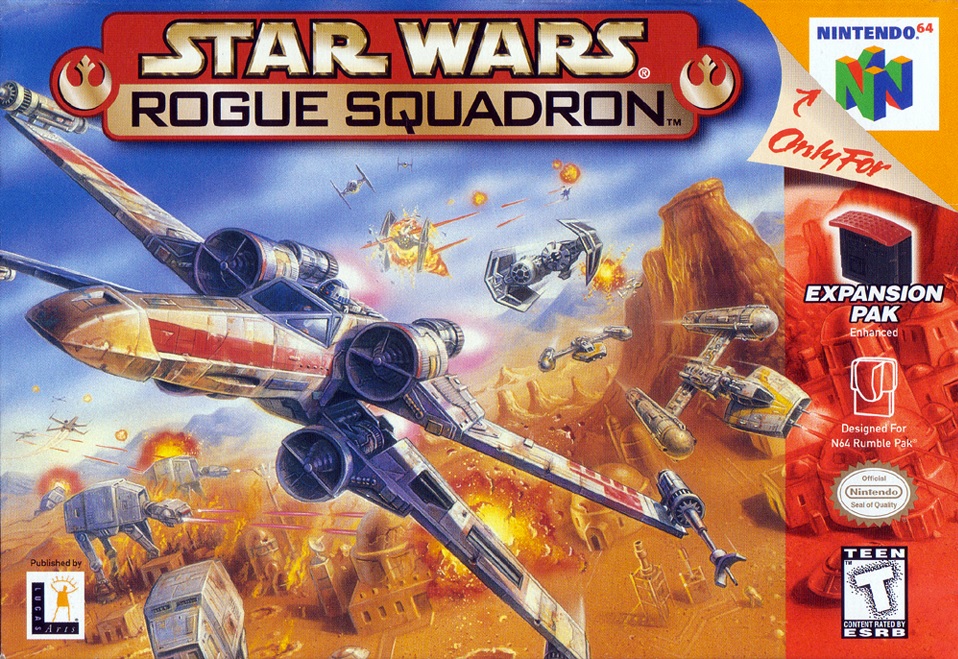
Star Wars Rogue Squadron N64 box cover
Another long-running video-game series began with Star Wars: Rogue Squadron for the Nintendo 64 and continued in Star Wars: Rogue Squadron II: Rogue Leader and Star Wars: Rogue Squadron III: Rebel Strike for the Nintendo GameCube. The first title was also available for PCs, and all were developed by Factor 5 and published by LucasArts. Rogue Squadron III featured emulated versions of the original Atari Star Wars arcade games.
Star Wars: Knights of the Old Republic, published in 2003, won "Game of the Year" recognition from several prominent gaming magazines, websites, etc. A sequel, Star Wars: Knights of the Old Republic II: The Sith Lords, was released for the Xbox in December of 2004 and the PC in February of 2005. Bioware released a MMORPG sequel to Knights of the Old Republic I and II called Star Wars: The Old Republic on December 20, 2011, set approximately 300 years after the events of Knights of the Old Republic II.
Star Wars Galaxies, an MMORPG developed by Sony, was released on June 26, 2003 in the United States, November 7 in Europe, December 23, 2004 in Japan, and in 2006 in Australia. The game was set after the events of the Battle of Yavin, and allowed players to create characters of a variety of species and specializations (such as Bounty Hunter and Smuggler) and choose to ally themselves with the Rebel Alliance or the Galactic Empire.
Star Wars: Battlefront was released in 2004 and is a first-/third-person shooter game capable of online play where you can play in both trilogies, as all factions, in many different battlefields. Its sequels, Star Wars: Battlefront II, Star Wars Battlefront: Renegade Squadron and Star Wars Battlefront: Elite Squadron, were released in 2005, 2007, and 2009 respectively.
Star Wars: Republic Commando is a tactical shooter computer game featuring the elite commandos of Delta Squad and set during the Clone Wars. It was released on March 1, 2005.
Star Wars: Empire at War, a real-time strategy game, was developed by Petroglyph Games and released on February 16, 2006, and an expansion pack, Star Wars: Empire at War: Forces of Corruption, was released in 2007.
LEGO Star Wars is a LEGO spinoff series in which the characters of Star Wars and most other vehicles and objects are made of LEGO bricks. The second game of the series is LEGO Star Wars II: The Original Trilogy. The third game of this series, LEGO Star Wars: The Complete Saga, combines the first two games. LEGO Star Wars III: The Clone Wars is a LEGO version of the Clone Wars animated series, taking place during seasons 1 and 2.
Three role-playing games set in the Star Wars universe have been published: a d6-based game from West End Games, a Wizards of the Coast game using the d20 system on which their popular Dungeons & Dragons is based, and a game from Fantasy Flight Games.
The cast of the movies feature notable actors, such as Sofia Coppola and Keisha Castle-Hughes. Notable supporting roles played by acclaimed actors include Alec Guinness, Peter Cushing, Christopher Lee and Oliver Ford Davies. In the prequel trilogy, professional models did the non-speaking minor-character roles.
The central theme of Star Wars is letting go. George Lucas believes that to be happy, one should accept all the happenings of reality and be compassionate by wholly letting go of their selfishness—including the fear of losing what one loves, which is an indicator of greed—to be more selfless.
Star Wars stresses the self-destructive nature of anger and hate, summed up in Yoda's words ( ) as well as placing one's feelings for certain people aside. For example, Luke Skywalker is told to remain on Dagobah to complete his training rather than rescue his friends from Cloud City, because doing so will "destroy all for which they have fought and suffered."
Lucas has identified the idea of a democracy becoming a dictatorship as the fundamental idea of the saga. He has stated that the saga raises such ideas as the people giving up their power in desperation, and betrayal by their leaders who may think they are doing the right thing while sacrificing freedom. In this way, Star Wars is a cautionary tale in which Lucas, by his own admission, warns people of the danger that is always present to democracy and freedom and has been demonstrated throughout history.
There appear to be anti-technological messages in the films: the primitive Ewoks defeating technological adversaries, and the general idea of technology opposed to humanity, fitting with Lucas' vision. Lucas explicitly attributed the Ewoks' defeat of the Galactic Empire to the exploits of the Vietnamese National Liberation Front (otherwise known as the Vietcong) that operated during the Vietnam War, and also implied in his 1973 draft that the Rebels were similar representations of said theme in the original film.
The main story arc in the films traces the rise, fall and redemption of Anakin Skywalker, mirrored by political events occurring on a galactic scale. As Anakin is seduced by the dark side, the Republic slides into despotism and war; when Anakin reclaims the Jedi values of peace and justice, the evil Empire that supplanted the Republic is overthrown by the Rebel Alliance.